
Private NFA collection • Gary Gelson photo
MP18/1 (WWI)
This was the first German submachine gun and it was designed by Hugo Schmeisser in 1916. It was used by German military forces in WWI. The gun was chambered for the 9mm Parabellum cartridge. The barrel length is 7.5 inches and the snail magazine holds 32 rounds. The rate of fire is about 450 rounds per minute. Markings are “MP 18 L” above the chamber and “C.G HANEL WAFFENFABRIK SUHL” on the left side of the receiver. Weight is about 9 lbs.
Pre-1968
Exc. |
V.G. |
Fair |
25000 |
17500 |
12000 |
Pre-1986 manufacture with new receiver or re-weld

Private NFA collection • Gary Gelson photo
Exc. |
V.G. |
Fair |
15000 |
12500 |
10000 |
MP18/1 (Postwar)
Introduced into combat by German troops in 1918. Designed by Hugo Schmeisser and built by Bergmann. Chambered for 9mm cartridge. In place of the 32-round snail drum, a box magazine holds 20 or 32 rounds. The magazine is essentially the only difference between the WWI guns and the postwar examples. Barrel length is 8 inches. Rate of fire is about 400 rounds per minute. Was in use from 1918 to 1930s. Weight is about 9 lbs.
Pre-1968
Exc. |
V.G. |
Fair |
22500 |
17000 |
12000 |
Pre-1986 manufacture with new receiver or re-weld
Exc. |
V.G. |
Fair |
15000 |
12500 |
10000 |
Bergman MP28
This model is an improved version of the MP18. It is fitted with a tangent sight and straight magazine. It also has a selector switch to allow for semi-auto fire. Rate of fire is approximately 500 rounds per minute. Chambered for a variety of calibers including 9mm Parabellum, 9mm Bergmann, 7.65mm Parabellum, 7.63mm, and .45 ACP. Magazine capacity is 20, 32, or 50 rounds with special 25-round magazine for .45 ACP models. Built in Belgium by Pieper. Many of these guns were sold to South American countries. They were also used by German Police units including SS units. It was never adopted by the German army. Markings over the chamber are “MP 28 II SYSTEM SCHMEISSER PATENT.” Weight is 8.8 lbs.

Courtesy Richard M. Kumor Sr.
Pre-1968
Exc. |
V.G. |
Fair |
18500 |
15000 |
10000 |
Pre-1986 manufacture with new receiver or re-weld
Exc. |
V.G. |
Fair |
9500 |
7500 |
6500 |
Erma EMP
First developed in Germany in 1934, this submachine gun was chambered for the 9mm cartridge. It was fitted with a wooden vertical fore-grip. The gun was fitted with a 9.75-inch barrel with a 20- or 32-round magazine. The rate of fire was 500 rounds per minute. The weight was about 8.25 lbs. Marked “EMP” on rear receiver cap. Production ceased in 1945. This gun was used extensively in the Spanish Civil War.

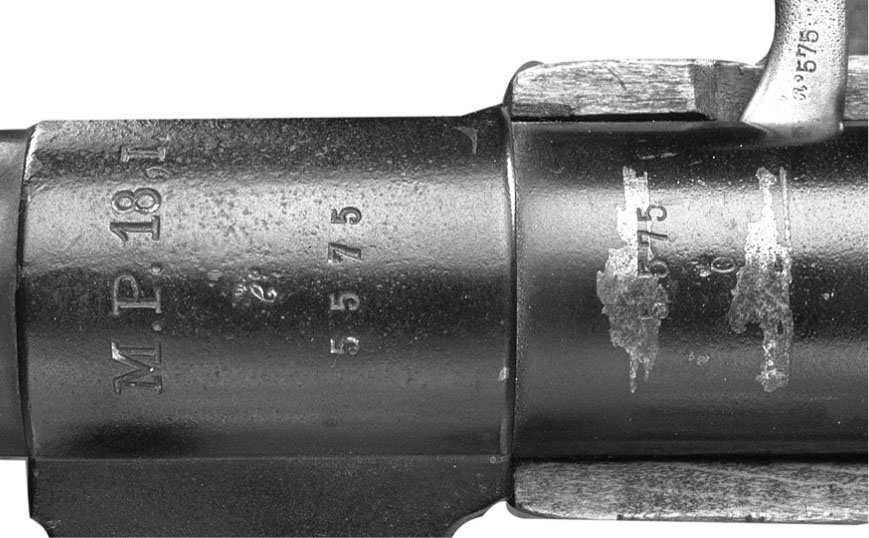

MP 18/1 with markings • Paul Goodwin Photo


Erma EMP • Paul Goodwin Photo
Pre-1968
Exc. |
V.G. |
Fair |
18000 |
15000 |
12000 |
Pre-1986 manufacture with new receiver or re-weld
Exc. |
V.G. |
Fair |
7500 |
5500 |
4500 |
Steyr-Solothurn (Solothurn SI-100 or MP34[o])
See Austria, Submachine Guns, Steyr.
MP34/I & MP35/I
Similar in appearance to the MP28, and produced in Germany by Walther in Zella Mehlis. Chambered for the 9mm cartridge and fitted with a 7.8- or 12.6-inch barrel. Other calibers were offered such as the 9mm Bergmann, 9mm Mauser, .45 ACP, and 7.63 Mauser. Rear sight had a V-notch tangent graduated to 1,000 meters. The gun had a cocking handle much like that of a rifle located at the rear of the receiver. Fitted with two triggers, the outer one fired semi-automatic and the inner one fired full automatic. The 24- or 32-round magazine fed from the right side. Rate of fire was about 650 rounds per minute and weight is approximately 9 lbs. The MP35/I was a modified MP34/I and was used by the German SS. Built by Junker & Ruh. Many more MP35/I guns were built than MP34/I.

Private NFA collection, Gary Gelson photo
Pre-1968
Exc. |
V.G. |
Fair |
18000 |
15000 |
12500 |
NOTE: For “SS” marked MP35 guns add $3,000.
MP38
This German submachine gun was first produced in 1938. It is often called the Schmeisser but that is incorrect. It was designed by Vollmer and built by the Erma company. It is chambered for the 9mm cartridge and is fitted with a 9.75" barrel. It has a folding stock and a magazine capacity of 32 rounds. Its rate of fire is 500 rounds per minute. Full automatic fire only. Weight is approximately 9 lbs. Marked “mp38” on the rear receiver cap. Production ceased in 1940. Produced by Erma. This was the standard submachine gun of the German army during World War II. Over 1,000,000 were produced.
NOTE: In 1940 and 1941 some Model 38s were modified to prevent accidental discharges, by replacing the one-piece retracting handle with a two-piece one that incorporated a cut-out which could be locked to prevent firing. This modified Model 38 is designated the Model 38/40.
Pre-1968 (Rare)
Exc. |
V.G. |
Fair |
25000 |
22500 |
17500 |
Pre-1986 manufacture with new receiver or re-weld
Exc. |
V.G. |
Fair |
8500 |
7500 |
6500 |


MP38 • Paul Goodwin photo

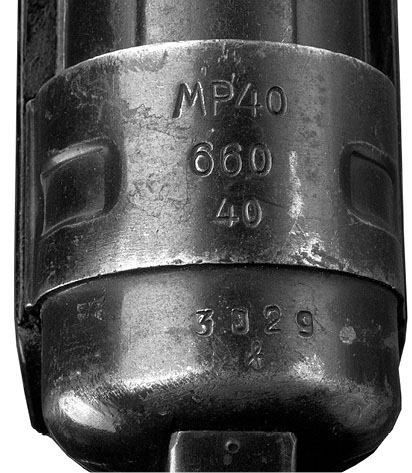
MP40 • Paul Goodwin photo
German Manufacturing Codes for the MP38 & MP40:
Erma |
1938 to 1940 |
“27” |
Erma |
1940 to 1944 |
“afy” |
Haenal |
1938 to 1940 |
“122” |
Haenal |
1940 to 1944 |
“fxo” |
Steyr |
1939 to 1940 |
“660” |
Steyr |
1940 to 1944 |
“bnz” |
MP40
This model was the successor to the MP38 with more quickly manufactured components. The steel receivers are pressed with a corrugated magazine housing. The grip frame is pressed steel as well. Weight and barrel length are the same as the MP38 as is magazine capacity and rate of fire. This model was produced from 1940 to 1945 by Erma. Marked “MP40” on the rear receiver cap. Approximately 1,000,000 of these guns were produced.
NOTE: There is a rare modification of this submachine gun designated the MP40/II, which is fitted with a magazine housing that holds two magazines. These magazines fit in an oversized sliding housing that moves laterally, allowing a full magazine to be moved into place when the first magazine becomes empty. Not developed until late 1943. Not considered a successful attempt to increase ammunition capacity.
Pre-1968
Exc. |
V.G. |
Fair |
18500 |
15000 |
10000 |
Pre-1986 manufacture with new receiver or re-weld
Exc. |
V.G. |
Fair |
8500 |
5000 |
N/A |
MP41
This model was built by Schmeisser to compete with the official adopted military MP40. The gun was not adopted by the German army. The result is that very few of these guns exist. The MP40-style receiver and barrel were fitted to a wooden buttstock and a select fire mechanism was added. Weight is about 8 lbs. Marked “MP41 PATENT SCHMEISSER C.G.HAENEL SUHL” on the top of the receiver. About 27,500 of these guns were built between 1941 and 1945.
Pre-1968 (Rare)
Exc. |
V.G. |
Fair |
19500 |
16000 |
12000 |
Pre-1986 manufacture with new receiver or re-weld
Exc. |
V.G. |
Fair |
8500 |
5000 |
N/A |

MP41 • Private NFA collection, Gary Gelson photo
Walther MPK and MPL
This German submachine gun was first produced in 1963. The MPK is a short barrel (6.7 inches) version and the MPL is the long barrel (10.14 inches) version. Magazine capacity is 32 rounds of 9mm. Rate of fire is 55 rounds per minute. Weight empty is 6.1 lbs. Markings are on the left side of the receiver. Production of this model ceased in 1985.

Courtesy private NFA collection
Pre-1968 (Rare)
Exc. |
V.G. |
Fair |
18000 |
15000 |
N/A |
HK MP5
First produced in 1965, this submachine gun is quite popular worldwide, being in service in a number of countries. It is produced in 9mm, .40 S&W, and 10mm. It is offered in a number of variations. The basic model is fitted with an 8.75-inch barrel with retractable stock. Magazine capacity is 15 or 30 rounds. Rate of fire is 800 rounds per minute. Weight is approximately 5.5 lbs. Marked “MP5 KAL 9MMX19” on top rib of receiver.

Courtesy Richard M. Kumor Sr.
Pre-1968 (Rare)
Exc. |
V.G. |
Fair |
19500 |
17500 |
16000 |
Pre-1986 conversions of semi-automatic version
Exc. |
V.G. |
Fair |
14500 |
13000 |
12000 |
NOTE: Add 15 percent for registered receiver using OEM parts.
HK MP5 K
This model is essentially the same as the MP5 with the exception of a 4.5-inch barrel. Weight is about 4.4 lbs.
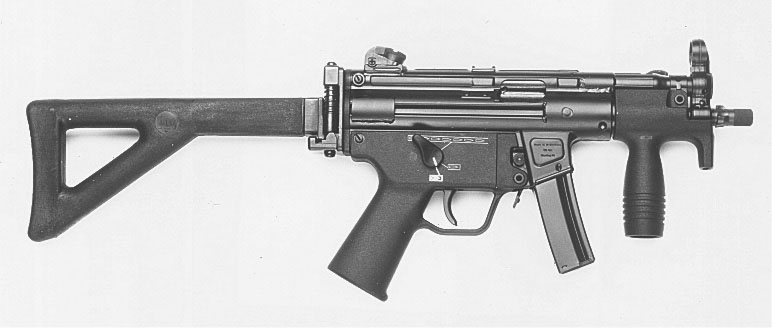
Courtesy Heckler & Koch
Pre-1968 (Rare)
Exc. |
V.G. |
Fair |
N/A |
N/A |
N/A |
Pre-1986 conversions of semi-automatic model
Exc. |
V.G. |
Fair |
15000 |
12500 |
N/A |
NOTE: Add 15 percent for registered receiver using OEM parts.
HK MP5 SD
This variation of the MP5 uses a suppressor, making it one of the quietest submachine guns ever. The barrel is ported so that supersonic 9mm ammunition can be used at subsonic levels. Rate of fire is 800 rounds per minute. Magazine capacity is 15 or 30 round magazines. Barrel length is 7.7" and weight is approximately 7 lbs. This model comes in six different configurations that may affect price.

Courtesy Heckler & Koch
Pre-1968
Exc. |
V.G. |
Fair |
N/A |
N/A |
N/A |
Pre-1986 conversions of semi-automatic model
Exc. |
V.G. |
Fair |
20000 |
17500 |
N/A |
NOTE: Add 15 percent for registered receiver using OEM parts.
HK 53
This submachine gun fires the 5.56×45mm cartridge. It is fitted with an 8.25-inch barrel and retractable stock. Magazine capacity is 25 rounds. Rate of fire is about 700 rounds per minute. Weight is approximately 6.7 lbs. Marked “MP53 KAL 5.56X45” on top rib of receiver. The gun is in service in several military and police units around the world.
Pre-1968
Exc. |
V.G. |
Fair |
N/A |
N/A |
N/A |
Pre-1986 conversions of HK 93
Exc. |
V.G. |
Fair |
15000 |
12000 |
N/A |

Courtesy Heckler & Koch

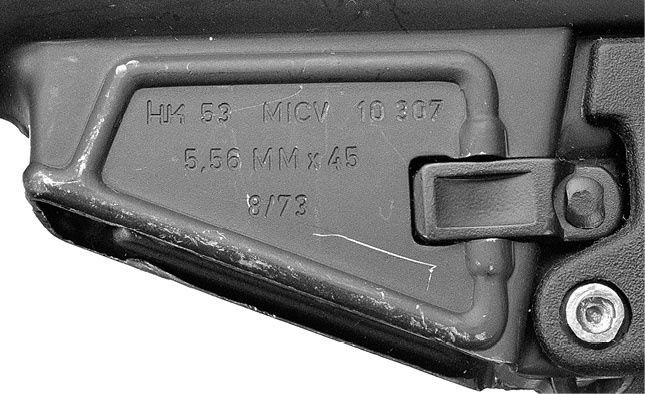
HK 53 in firing port configuration • Paul Goodwin Photo
German Pre-Cartridge Era Rifles
Germany did not exist as a single nation until 1871. It was made of at least 26 nation-states, principalities, and city-states that unified into a single confederation called the German Empire at that time. Prior to unification, each of these individual states purchased their own arms and it is not possible to list more than a sample here. Prussia was the largest and most prominent of these states and it is their arms that are listed here.
Prussian Model 1809 Flintlock Musket
Usually referred to as a Postdam musket, and that name is sometimes found on the lock plate. Total length of 56-1/2 inches with a 41-inch barrel. .75 caliber, smooth bore. Weight is about 9 lbs. This is similar to the M 1777 muskets used by the Hessians in the U.S. Revolution. A pre-1800 example would bring 25-50% more.

Exc. |
V.G. |
Good |
Fair |
Poor |
2250 |
1600 |
1250 |
650 |
400 |
Prussian M1809 Conversion to Percussion
Sometimes referred to as a 1809/39.
Exc. |
V.G. |
Good |
Fair |
Poor |
1250 |
900 |
750 |
450 |
250 |
Prussian M1839 Percussion Musket
As above but manufactured as a percussion firearm. .71 caliber.

Exc. |
V.G. |
Good |
Fair |
Poor |
1250 |
900 |
750 |
450 |
250 |
NOTE: Some Prussian muskets were issued to Northern regiments early in the American Civil War. Add 100% to any 1809/39 or 1839 musket with unit or state markings.
Dreyse Needle Gun
The Dreyse needle-gun was a military breechloading rifle, famous as the main infantry weapon of the Prussians, who adopted it for service in 1841 as the Dreyse Zündnadelgewehr, or Prussian Model 1841. Its name comes from its 0.5-inch (13mm) needle-like firing pin, which passed through the paper cartridge case to impact a percussion cap seated in the base of the bullet. The Dreyse rifle was also the first breech-loading rifle to use a bolt to open and close the chamber, executed by turning and pulling a bolt handle. The gun was the invention of the gunsmith Johann Nikolaus von Dreyse.

Prussian M1841 Dreyse Needle Gun
Caliber 15.4mm. Total length of 53 inches. Barrel length is 33-1/2 inches. The weight is about 10 ½ lb.


This view shows the Dreyse action with the bolt open. The needle can be seen in the front of the bolt.
Exc. |
V.G. |
Good |
Fair |
Poor |
3000 |
2250 |
1600 |
900 |
450 |
Prussian M 1857 Dreyse Needle Carbine
Caliber 15.4mm. Total length of 31-1/2 inches. The barrel is 15 inches. Weight is about 6-1/2 lbs. Stocked to the muzzle with a shoulder strap ring under the wrist of the stock.
Exc. |
V.G. |
Good |
Fair |
Poor |
3500 |
2700 |
1850 |
1000 |
575 |
Prussian M1862 Dreyse Needle Rifle
An improved version of the 1841 with a shorter barrel.

Exc. |
V.G. |
Good |
Fair |
Poor |
2500 |
1750 |
1250 |
750 |
500 |
Bayonets for Dreyse Rifles
There were a few patterns of socket bayonet made for the Dreyse rifles, as shown in the images above. Price range 250-150.
FOR COUNTRIES NOT LISTED UNDER SEPARATE HEADING
Note: Many of these models have never been imported to the U.S. in quantity. In some cases only a handful of a given model exist and no recent sales activity could be documented to establish a price range. In these cases, the prices listed are educated estimates.
Argentina
See Argentina, Rifles, Mauser.
Austria
See Austria, Rifles, Mauser.
Belgium
See Belgium, Rifles, Mauser.
Bolivia
M1895 Rifle
Exc. |
V.G. |
Good |
Fair |
800 |
550 |
250 |
150 |
M1907 Rifle
Exc. |
V.G. |
Good |
Fair |
850 |
575 |
250 |
150 |
M1907 Short Rifle
Exc. |
V.G. |
Good |
Fair |
850 |
575 |
250 |
150 |
VZ24 Short Rifle
Exc. |
V.G. |
Good |
Fair |
850 |
600 |
300 |
225 |
M1933 Standard Model Export Model Short Rifle
Exc. |
V.G. |
Good |
Fair |
900 |
675 |
450 |
250 |
M1950 Series B-50 Rifle
Exc. |
V.G. |
Good |
Fair |
600 |
450 |
375 |
225 |
Brazil
See Brazil, Rifles, Mauser.
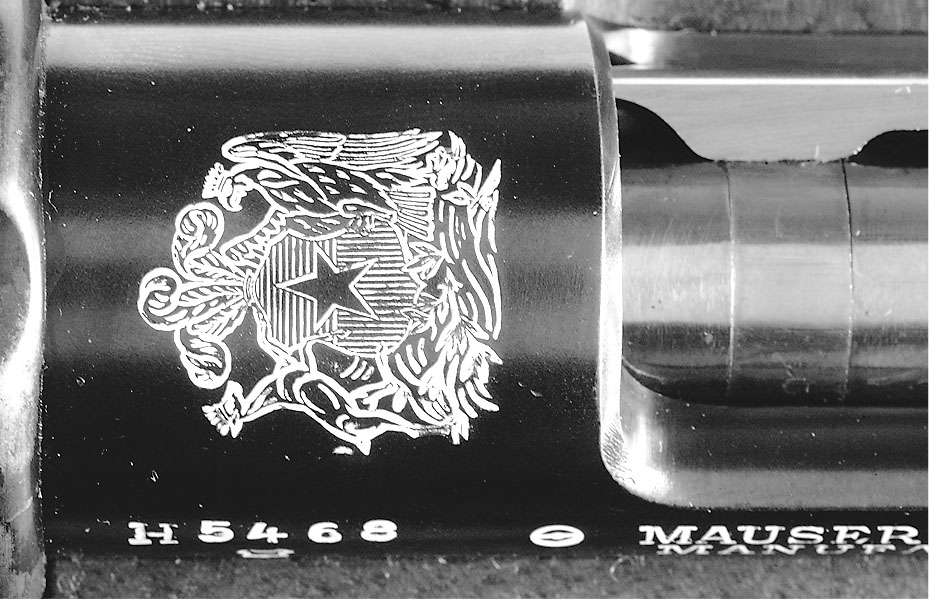
Courtesy Rock Island Auction Company
Chile
M1893 Rifle
Exc. |
V.G. |
Good |
Fair |
600 |
475 |
250 |
150 |
M1895 Rifle

Courtesy Rock Island Auction Company
Exc. |
V.G. |
Good |
Fair |
550 |
450 |
275 |
150 |
M1895/61 7.62 NATO Conversion
Exc. |
V.G. |
Good |
Fair |
400 |
300 |
250 |
175 |
M1895 Short Rifle
Exc. |
V.G. |
Good |
Fair |
550 |
425 |
300 |
150 |
Bayonet for Chilean Model 1895 Mauser
Wood grips. 9.8-inch single edge blade. Muzzle ring. Chilean Star in shield marking on one side of ricasso. Maker marked Weyersberg, Kirschbaun & Co. Solingen. SN: on cross piece and scabbard frog stud. Price range 45 – 20.
M1896 Carbine
Exc. |
V.G. |
Good |
Fair |
600 |
425 |
250 |
150 |
M1912 Steyr Rifle

Courtesy Rock Island Auction Company
Exc. |
V.G. |
Good |
Fair |
650 |
475 |
300 |
175 |

Bayonet for Chilean Model 1895 Mauser

Bayonet for Chilean Model 1912 Mauser


M1935 Carabineros Carbine • Courtesy Rock Island Auction Company
M1912 Steyr Short Rifle
Exc. |
V.G. |
Good |
Fair |
650 |
475 |
300 |
175 |
M1912/61 7.62 NATO Conversion
Exc. |
V.G. |
Good |
Fair |
400 |
325 |
250 |
150 |
Bayonet for Chilean Model 1912 Mauser
Wood grips. 9.8-inch single edge blade. Muzzle ring. Made in Austria by Steyr. Marked OEWG. Steel scabbard that is the same style as the M1895 bayonet comes in. Price range 70 – 35.
M1935 Carabineros Carbine
Exc. |
V.G. |
Good |
Fair |
800 |
650 |
450 |
300 |
China
See China, Rifles, Mauser.
Colombia
M1891 Rifle (Argentine Pattern)
Exc. |
V.G. |
Good |
Fair |
550 |
400 |
275 |
150 |
M1904 Rifle
Exc. |
V.G. |
Good |
Fair |
700 |
525 |
300 |
175 |
M1912 Steyr Rifle
Exc. |
V.G. |
Good |
Fair |
750 |
500 |
300 |
175 |
VZ23 Short Rifle
Exc. |
V.G. |
Good |
Fair |
750 |
550 |
300 |
175 |
Steyr-Solothurn A-G M1929 Short Rifle
Exc. |
V.G. |
Good |
Fair |
750 |
550 |
300 |
175 |
FN M24 and 30 Short Rifles
Exc. |
V.G. |
Good |
Fair |
750 |
575 |
350 |
175 |
VZ12/33 Carbine
Exc. |
V.G. |
Good |
Fair |
800 |
625 |
450 |
275 |
FN M1950 Short Rifle
Exc. |
V.G. |
Good |
Fair |
700 |
525 |
350 |
200 |
Costa Rica
M1895 Rifle
Exc. |
V.G. |
Good |
Fair |
550 |
400 |
250 |
150 |
M1910 Rifle
Exc. |
V.G. |
Good |
Fair |
600 |
475 |
300 |
175 |
FN M24 Short Rifle
Exc. |
V.G. |
Good |
Fair |
750 |
500 |
300 |
175 |
Czechoslovakia
See Czechoslovakia, Rifles, Mauser.
Denmark
See Denmark, Rifles, Mauser.
Dominican Republic
M1953 Rifle
Exc. |
V.G. |
Good |
Fair |
700 |
500 |
300 |
150 |
M1953 Short Rifle
Exc. |
V.G. |
Good |
Fair |
650 |
425 |
250 |
150 |
Ecuador
M71/84 Rifle
Exc. |
V.G. |
Good |
Fair |
850 |
650 |
500 |
325 |
M1891 Rifle (Argentine Pattern)
Exc. |
V.G. |
Good |
Fair |
750 |
475 |
275 |
150 |
M1907 Rifle
Exc. |
V.G. |
Good |
Fair |
700 |
550 |
350 |
175 |
M1910 Rifle
Exc. |
V.G. |
Good |
Fair |
700 |
500 |
300 |
175 |
VZ24 Short Rifle
Exc. |
V.G. |
Good |
Fair |
700 |
500 |
300 |
175 |
VZ12/33 Carbine
Exc. |
V.G. |
Good |
Fair |
850 |
575 |
350 |
200 |
FN M30 Short Rifle
Exc. |
V.G. |
Good |
Fair |
750 |
550 |
300 |
175 |
El Salvador
M1895 Rifle
Exc. |
V.G. |
Good |
Fair |
650 |
400 |
250 |
150 |
VZ12/33 Carbine
Exc. |
V.G. |
Good |
Fair |
850 |
575 |
400 |
250 |
Estonia
Czech Model L Short Rifle
Exc. |
V.G. |
Good |
Fair |
1200 |
850 |
550 |
250 |
Ethiopia
FN M24 Carbine
Exc. |
V.G. |
Good |
Fair |
800 |
650 |
400 |
200 |
M1933 Standard Model Short Rifle
Exc. |
V.G. |
Good |
Fair |
850 |
700 |
550 |
250 |
M1933 Standard Model Carbine
Exc. |
V.G. |
Good |
Fair |
850 |
600 |
400 |
250 |
France
See France, Rifles, Mauser.
Greece
M1930 Short Rifle
Exc. |
V.G. |
Good |
Fair |
850 |
575 |
400 |
250 |
M1930 Carbine
Exc. |
V.G. |
Good |
Fair |
850 |
575 |
400 |
300 |
Guatemala
M1910 Rifle
Exc. |
V.G. |
Good |
Fair |
550 |
400 |
300 |
150 |
VZ25 Short Rifle (Model 24)
Exc. |
V.G. |
Good |
Fair |
550 |
400 |
325 |
175 |
VZ33 Carbine
Exc. |
V.G. |
Good |
Fair |
750 |
575 |
350 |
200 |
Haiti
FN M24/30 Short Rifle
Exc. |
V.G. |
Good |
Fair |
750 |
525 |
350 |
175 |
Honduras
G 71 Rifle
Exc. |
V.G. |
Good |
Fair |
850 |
650 |
500 |
350 |
M1895 Rifle (Chilean Pattern)
Exc. |
V.G. |
Good |
Fair |
550 |
400 |
300 |
150 |
M1933 Standard Model Short Rifle
Exc. |
V.G. |
Good |
Fair |
750 |
500 |
350 |
175 |
Iraq
Post-WWII-style Carbine Model 48, Made in Yugoslavia.
Exc. |
V.G. |
Good |
Fair |
600 |
500 |
300 |
150 |
Ireland
G 71 Rifle
Exc. |
V.G. |
Good |
Fair |
800 |
650 |
450 |
275 |
Israel
See Israel, Rifles, Mauser.
Japan
See Japan, Rifles, Mauser.
Latvia
VZ24 Short Rifle
Exc. |
V.G. |
Good |
Fair |
850 |
700 |
550 |
350 |
Liberia
FN M24 Short Rifle
Exc. |
V.G. |
Good |
Fair |
800 |
575 |
350 |
175 |
Lithuania
FN M30 Short Rifle
Exc. |
V.G. |
Good |
Fair |
1500 |
900 |
750 |
450 |
FN M24 Short Rifle
Exc. |
V.G. |
Good |
Fair |
800 |
575 |
400 |
250 |
Luxembourg
M1900 Rifle
Exc. |
V.G. |
Good |
Fair |
850 |
650 |
475 |
300 |
FN M24/30 Short Rifle
Exc. |
V.G. |
Good |
Fair |
700 |
575 |
350 |
200 |
Manchuria
See Japan, Rifles.
Mexico
See Mexico, Rifles, Mauser.
Morocco
Post-WWII FN Carbine
Made in .30-06 and 7.62mm. FN address only. No crest. A small quantity were mported in the 1990s.
Exc. |
V.G. |
Good |
Fair |
650 |
475 |
350 |
200 |
Netherlands
See Netherlands, Rifles, Mauser.
Nicaragua
VZ23 Short Rifle
Exc. |
V.G. |
Good |
Fair |
650 |
500 |
350 |
175 |
VZ12/33 Carbine
Exc. |
V.G. |
Good |
Fair |
750 |
600 |
450 |
200 |
Norway
See Norway, Rifles, Mauser.
Orange Free State
M1895 Rifle
Exc. |
V.G. |
Good |
Fair |
800 |
625 |
450 |
225 |
M1895 Chilean-marked Rifle
Exc. |
V.G. |
Good |
Fair |
750 |
550 |
400 |
225 |
M1896 Loewe & Co. Rifle
Exc. |
V.G. |
Good |
Fair |
900 |
750 |
450 |
225 |
M1897 DWM Rifle
Exc. |
V.G. |
Good |
Fair |
900 |
750 |
450 |
250 |
Paraguay
M1895 Rifle (Chilean Pattern)
Exc. |
V.G. |
Good |
Fair |
550 |
400 |
275 |
150 |
M1907 Rifle
Exc. |
V.G. |
Good |
Fair |
650 |
475 |
300 |
175 |
M1907 Carbine
Exc. |
V.G. |
Good |
Fair |
650 |
475 |
300 |
175 |
M1909 Haenel Export Model Rifle
Exc. |
V.G. |
Good |
Fair |
750 |
600 |
450 |
175 |
M1927 Rifle
Exc. |
V.G. |
Good |
Fair |
550 |
375 |
250 |
150 |
M1927 Short Rifle
Exc. |
V.G. |
Good |
Fair |
550 |
375 |
250 |
150 |
FN M24/30 Short Rifle
Exc. |
V.G. |
Good |
Fair |
750 |
525 |
350 |
175 |
M1933 Standard Model Short Rifle
Exc. |
V.G. |
Good |
Fair |
750 |
575 |
400 |
250 |
M1933 Standard Model Carbine
Exc. |
V.G. |
Good |
Fair |
750 |
575 |
400 |
250 |
Persia/Iran
M1895 Rifle
Exc. |
V.G. |
Good |
Fair |
750 |
600 |
400 |
150 |
FN M24/30 Short Rifle
Exc. |
V.G. |
Good |
Fair |
900 |
700 |
500 |
175 |
M98/29 Long Rifle
CZ mfg. Several thousand were imported in the 1990s. They were in V.G. to Exc. condition.
Exc. |
V.G. |
Good |
Fair |
600 |
500 |
300 |
175 |
VZ24 Short Rifle
Exc. |
V.G. |
Good |
Fair |
850 |
700 |
500 |
250 |
M30 Carbine
Exc. |
V.G. |
Good |
Fair |
750 |
600 |
400 |
175 |
M49 Carbine
Exc. |
V.G. |
Good |
Fair |
750 |
600 |
450 |
175 |
Peru
M1891 Rifle M1891 Carbine
Exc. |
V.G. |
Good |
Fair |
650 |
500 |
300 |
150 |
M1895 Rifle
Exc. |
V.G. |
Good |
Fair |
450 |
325 |
250 |
150 |
M1909 Rifle
Exc. |
V.G. |
Good |
Fair |
800 |
650 |
400 |
175 |
VZ24 Short Rifle
Exc. |
V.G. |
Good |
Fair |
750 |
475 |
300 |
175 |
VZ33 Carbine
Exc. |
V.G. |
Good |
Fair |
800 |
550 |
350 |
175 |

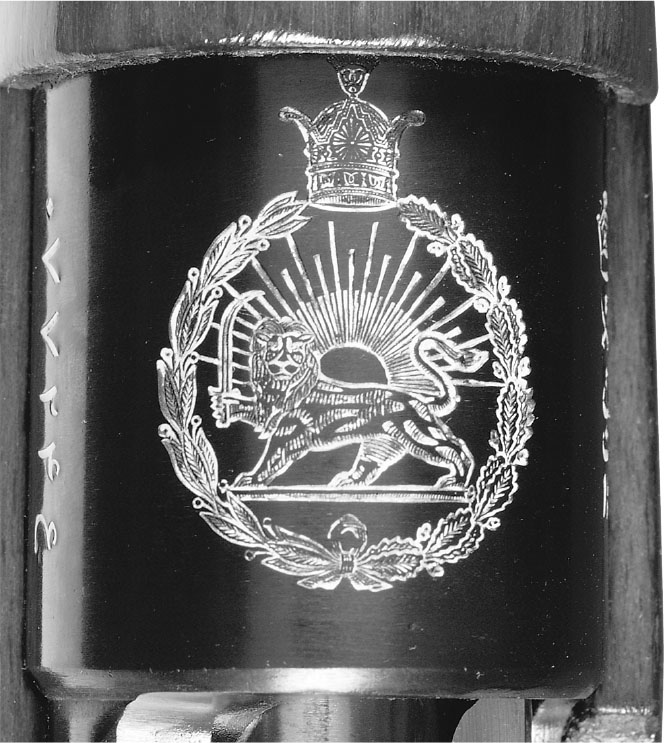
Persian M98/29 Long Rifle • Courtesy Rock Island Auction Company
M1935 Short Rifle (converted to .30-06)
Exc. |
V.G. |
Good |
Fair |
450 |
325 |
250 |
150 |
M1935 Short Rifle

Courtesy Rock Island Auction Company
Exc. |
V.G. |
Good |
Fair |
600 |
475 |
300 |
175 |
Poland
See Poland, Rifles, Mauser.
Portugal
See Portugal, Rifles, Mauser.
Romania
See Romania, Rifles.
Saudi Arabia
FN M30 Short Rifle
Exc. |
V.G. |
Good |
Fair |
1000 |
750 |
500 |
250 |
Serbia/Yugoslavia
See Yugoslavia, Rifles, Mauser.
Slovak Republic
VZ24 Short Rifle
Exc. |
V.G. |
Good |
Fair |
800 |
575 |
400 |
250 |
South Africa
M1896 ZAR Rifle
Exc. |
V.G. |
Good |
Fair |
1000 |
800 |
500 |
250 |
ZAR M1896 B Series Rifle
Exc. |
V.G. |
Good |
Fair |
850 |
650 |
500 |
250 |
M1896 ZAR Loewe Long Rifle
Exc. |
V.G. |
Good |
Fair |
850 |
650 |
500 |
250 |
M1895/1896 C Series
Exc. |
V.G. |
Good |
Fair |
800 |
600 |
500 |
175 |
Spain
See Spain, Rifles, Mauser.
Sweden
See Sweden, Rifles, Mauser.
Syria
M1948 Short Rifle
Exc. |
V.G. |
Good |
Fair |
500 |
375 |
250 |
125 |
Thailand/Siam
G 71 Rifle
Exc. |
V.G. |
Good |
Fair |
850 |
600 |
400 |
300 |
M1903 (Type 45) Rifle
Made in Japan at the Koishikowa arsenal.
Exc. |
V.G. |
Good |
Fair |
450 |
325 |
250 |
150 |
M1904 Rifle
Exc. |
V.G. |
Good |
Fair |
450 |
325 |
250 |
150 |
M1923 (Type 66) Short Rifle
Exc. |
V.G. |
Good |
Fair |
450 |
325 |
250 |
150 |
Transvaal
G 71 Rifle
Exc. |
V.G. |
Good |
Fair |
850 |
675 |
500 |
300 |
Turkey
See Turkey, Rifles, Mauser.
Uruguay
G 71 Rifle
Exc. |
V.G. |
Good |
Fair |
850 |
650 |
500 |
300 |
M1895 Rifle
Exc. |
V.G. |
Good |
Fair |
750 |
600 |
400 |
250 |
M1908 Rifle
Exc. |
V.G. |
Good |
Fair |
750 |
500 |
350 |
250 |
M1908 Short Rifle
Exc. |
V.G. |
Good |
Fair |
650 |
450 |
350 |
150 |
FN M24 Short Rifle
Exc. |
V.G. |
Good |
Fair |
700 |
525 |
350 |
175 |
VZ37 (937) Short Rifle
Exc. |
V.G. |
Good |
Fair |
700 |
550 |
300 |
175 |
VZ37 (937) Carbine
Exc. |
V.G. |
Good |
Fair |
700 |
550 |
300 |
175 |
Venezuela
G 71/84 Rifle
Exc. |
V.G. |
Good |
Fair |
850 |
650 |
500 |
350 |

Syrian M1948 Short Rifle • Courtesy Rock Island Auction Company

VZ24 Short Rifle • Courtesy Stoddard Martial collection, Paul Goodwin photo

FN M24/30 Short Rifle • Courtesy Cherry’s Fine Guns

FN M24/30 Carbine • Courtesy Rock Island Auction Company
M1910 Rifle
Exc. |
V.G. |
Good |
Fair |
575 |
450 |
300 |
150 |
VZ24 Short Rifle
Exc. |
V.G. |
Good |
Fair |
750 |
500 |
375 |
250 |
FN M24/30 Short Rifle
Exc. |
V.G. |
Good |
Fair |
800 |
600 |
450 |
250 |
FN M24/30 Carbine
Exc. |
V.G. |
Good |
Fair |
900 |
750 |
500 |
250 |
FN M24/30 Military Target Rifle
Exc. |
V.G. |
Good |
Fair |
1200 |
850 |
700 |
300 |
Yemen
FN M30 Short Rifle
Exc. |
V.G. |
Good |
Fair |
950 |
750 |
500 |
250 |
GERMAN ISSUE RIFLES
Established in 1869 by Peter and Wilhelm Mauser, this company came under the effective control of Ludwig Loewe and Company of Berlin in 1887. In 1896 the latter company was reorganized under the name Deutsches Waffen und Munition or, as it is better known, DWM.
For history and technical details, see Robert W.D. Ball’s Mauser Military Rifles of the World, Krause Publications.
Model 1871
This was the first German metallic cartridge rifle. It was a 11×60Rmm caliber single shot bolt action rifle with a 33.5-inch barrel with bayonet lug, full-length stock secured by two barrel bands, and a cleaning rod. There is no upper handguard on this model. This model did not have an ejector so empty shells had to be removed manually. The rear sight was a leaf type with graduations out to 1,600 meters. Weight was about 10 lbs. The barrel was marked “Mod. 71” together with the year of production and the manufacturer’s name, of which there were several. First produced in 1875. Blued with a walnut stock.

Courtesy Milwaukee Public Museum, Milwaukee, Wisconsin
Exc. |
V.G. |
Good |
Fair |
1150 |
850 |
600 |
300 |
Model 1871 Jaeger Rifle
As above, with a 29.4-inch barrel and finger grip extension behind the triggerguard. Weight is about 10 lbs.
Exc. |
V.G. |
Good |
Fair |
1400 |
900 |
650 |
450 |
Bayonet for Mauser Model 1871
Brass handle. Muzzle ring. S shaped quillon. 18.3-inch single edge blade. Brass tipped leather scabbard. Makers mark on speciman shown “Gebr Weyersberg, Solingen.” Price range 300 – 175.


Mauser Model 1871 Jager Rifle cal. 11mm single shot

Bayonet for Mauser Model 1871

Pioneer Bayonet for Mauser Model 1871
Pioneer Bayonet for 1871 Mauser
Brass handle. Muzzle ring. S shaped quillon. 20-inch heavy blade with saw back. Brass-tipped leather scabbard. Rare. Issued to engineer units only. Price range 800 – 400.
Model 1871 Carbine
As above, with a 20-inch barrel and no bayonet lug. Full stocked to the muzzle. Weight is about 7.5 lbs.

1871 Mauser Carbine, Kar 71 • Courtesy Bob Ball
Exc. |
V.G. |
Good |
Fair |
1500 |
950 |
700 |
350 |
Model 1871 Short Rifle
As above, but with upper and lower barrel bands and bayonet lug.
Exc. |
V.G. |
Good |
Fair |
1150 |
875 |
650 |
350 |
Model 79 G.A.G. Rifle (Grenz-Aufsichts-Gewehr)
Fitted with a 25-inch barrel and built by Haenel in Suhl and so marked. It is also marked “G.A.G.” Used by German border guards. It is full stock almost to the muzzle. It is chambered for the 11×37.5mm cartridge. Weight is about 7 lbs. Single shot.
Exc. |
V.G. |
Good |
Fair |
1000 |
750 |
550 |
300 |
Model 71/84 Rifle
The Model 71 modified by the addition of a tubular 8-round magazine. This model was fitted with an ejector. Barrel length 31.5 inches. Weight is approximately 10 lbs. Issued in 1886. About 900,000 were produced. Marked “I.G.MOD.71/84” on the left side of the receiver.
Exc. |
V.G. |
Good |
Fair |
1000 |
800 |
550 |
350 |
Bayonet for Mauser 71/84
Wood grips. Muzzle ring. 10-inch single edge blade. Steel scabbard. This was the first standard issue knife type bayonet. Also used on the Gew-1888 rifle. These are somewhat rare as many were converted for use on the Gew-98 during WWI. Price range 250 – 125.

Model 71/84 Rifle • Courtesy Rock Island Auction Company

Bayonet for Mauser 71/84
Model 88 Commission Rifle
A 7.92×57mm caliber bolt action rifle with a 29-inch barrel that is covered with a hollow steel tube. 5-shot magazine that requires Mannlicher type clips, full-length stock, bayonet lug, and cleaning rod. Marked “GEW. 88” together with the year of manufacture and the maker’s name. This was the first military rifle to take a rimless cartridge. Weight is about 9 lbs. About 1,000,000 of these rifles were produced. Many of these rifles were later modified to feed without the Mannlicher clip. This model is known as a M-88/05. Used in World War I by the German, Austro-Hungarian, Bulgarian, and Turkish armies. Original Commission 88 rifles are uncommon.

Exc. |
V.G. |
Good |
Fair |
800 |
500 |
350 |
150 |
Model 88 Turkish Rework
Germany provided many Model 1888’s to Turkey who used them in WW1 and later. They were re-worked to the 88-05 pattern and usually have a rear sight marked with Farsi numerals. Most have a small crescent marking on the receiver ring. Parts will have mixed serial numbers. Many of these were imported with the Turkish Mausers in the 1990s.
Exc. |
V.G. |
Good |
Fair |
250 |
200 |
150 |
100 |
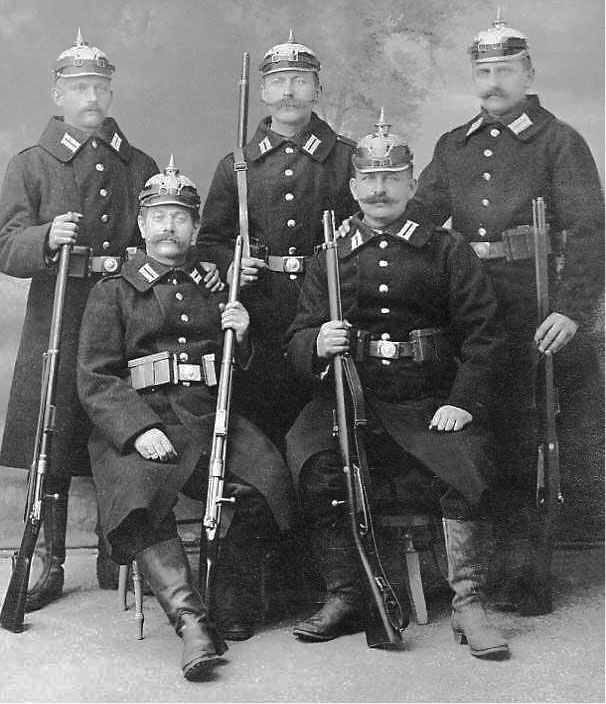
Model 88 Commission Rifle • Courtesy Paul S. Scarlata
Model 88 Commission Carbine
A 7.92×57mm caliber bolt action rifle with a 20-inch barrel, 5-shot magazine, full-length stock. Marked “Kar. 88” together with the year of manufacture and the maker’s name.
Exc. |
V.G. |
Good |
Fair |
850 |
650 |
500 |
350 |

Kar.88 Carbine

Clip for Gew-1888 Rifle or Kar-88 Carbine. Not needed on the 88/05
Model 98 Rifle (Gewehr 98)
The best known of all Mauser rifles. A 7.92mm bolt- action rifle with a 29-inch barrel, 5-shot flush fitting magazine, full-length stock, half-length handguard, cleaning rod, and bayonet lug. Pre-1915 versions had a steel grommet through the buttstock and finger grooves on the forend. These early guns also were fitted with a V-notch rear sight adjustable from 400 to 2,000 meters. This sight was called a “Lange Vizier”. It is known to U.S. collectors as the “roller coaster” sight. Rifles built after World War I were fitted with tangent rear sights graduated from 100 to 2,000 meters. Marked “GEW. 98” together with the date of manufacture and maker’s name. Weight is about 9 lbs. About 3,500,000 of these rifles were built from its introduction in 1898 to 1918.

Gew 1888 • Courtesy Paul S. Scarlata
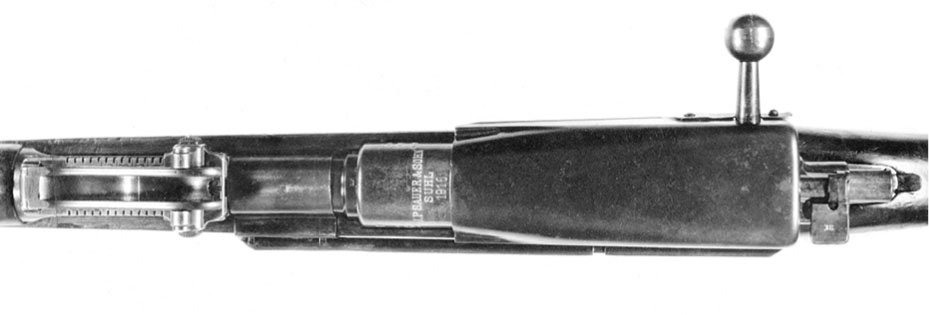
Mauser Gew 98 with trench cover • Courtesy John M. Miller
This rifle was built by the following government arsenals and commercial firms: Amberg, Danzig, Erfurt, Spandau, Mauser, DWM, J.P. Sauer & Sohn, V. Chr. Schilling, C.G. Haenel, Simson & Co., and Waffenwerke Oberspree Kornbusch & Co. Nearly all parts have the last 2 digits of the serial number. Price assumes matching numbers. Deduct 25-75% for miss match.
Exc. |
V.G. |
Good |
Fair |
850 |
675 |
450 |
200 |
Bayonet for Gew 1898 Mauser
Wood grip. No muzzle ring. 20.6-inch thin blade with single edge. Also made in a sawback version that was issued to noncommissioned officers. Maker’s name on ricasso. Dated on top of blade in front of crosspiece. Steel tipped leather or all steel scabbards were made. This is the first bayonet issued for the Gew-98. The design was dropped when it was discovered that the thin blade could be easily bent or broken in service. Price range standard blade version 225 – 125. Price range sawback version 400 – 200.
Model 98 Carbine
17-inch barrel and full stock to the muzzle without handguard. Turned-down bolt with a spoon shaped handle, as on the Kar-88. The rear sight resembles a shorter version of the Gew-98 sight, graduated to 1800 meters. Not fitted for a bayonet. Produced at the Erfurt arsenal from 1900 to 1902. About 3,000 were produced. In 1902 the Model 98A, with bayonet bar and cleaning rod, was also produced at Erfurt until 1905. Weight was about 7.5 lbs. Very rare. Only a few examples survive.
Exc. |
V.G. |
Good |
Fair |
2500 |
2000 |
1500 |
1000 |
Model 98 AZ Carbine/Model 98a
This model has the same stock as the Model Gew 98 but with a slot through the buttstock. Barrel length was 24". Bolt handle was turn down type and the full stock went to the muzzle with full upper handguard. Fitted with a bayonet stud and curved stacking bar on the forearm cap. Magazine capacity is 5 rounds. Weight is about 8 lbs. Introduced in 1908 with about 1,500,000 total production. Stamped “kar 98” on the left side of the receiver. After WWI these rifles were renamed the Model 98a. Fitted with a small ring receiver. Nearly all parts have the last 2 digits of the serial number. Price assumes matching numbers. Deduct 25-75% for miss match.
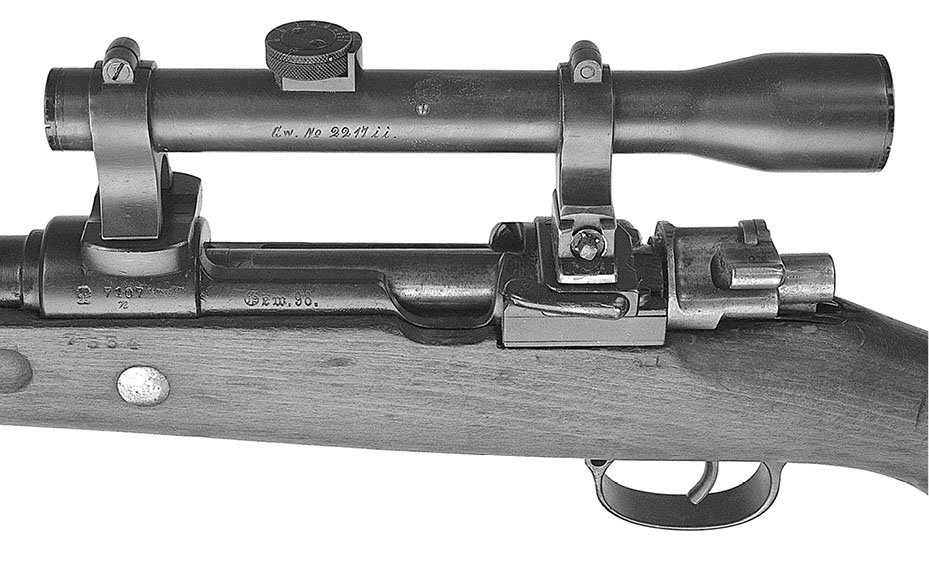

Bayonets for Gew 1898 Mauser: sawback (top) and standard

World War I Gew 98 Sniper with offset claw mount • Private Collection, Paul Goodwin photo

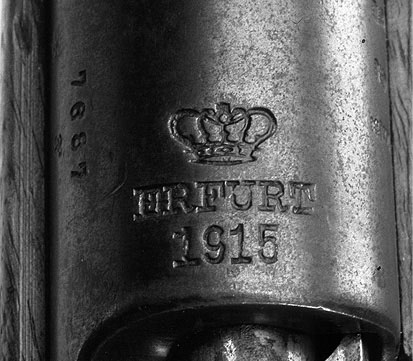
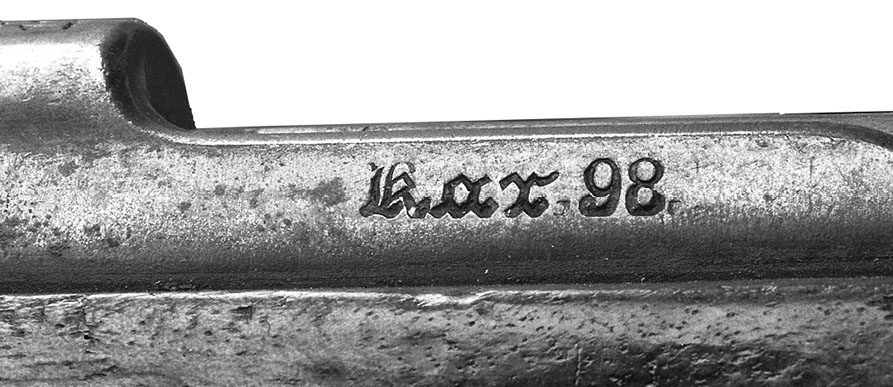
Model 98 AZ • Courtesy West Point Museum, Paul Goodwin photo
Exc. |
V.G. |
Good |
Fair |
850 |
600 |
450 |
250 |
German Bayonets of WWI
Germany used a wide variety of bayonets on the Mauser Gew-8 and Kar-98 rifles. They entered the war issuing the 1898/05 or “Butcher blade” model. As the war progressed the shorter blade types and the ersatz models were introduced.
A whole chapter could be devoted to the German WWI bayonets. We have room for only a few types here. A small percentage of German bayonets were made with a sawback. They were issued only to noncommissioned officers or pioneer troops. The German model designations are used in the headings.
S98/05
Wood handle. Swept back quillon. 14.5-inch single edge “butcher” style blade. Maker marked on the ricasso. Dated on top of the blade in front of the cross piece. Some early versions have the saw back. This was phased out during the war due to negative allied propaganda. Most had the saw back ground off and were re-issued. The first scabbards were leather with steel fittings, followed by all steel.

Mauser 98 AZ • Courtesy Paul S. Scarlata
Price ranges:
98/05 with saw back 250 – 125.
98/05 with saw back removed 175 – 75.
98/05 made without saw back 150 – 50.
S84/98 WWI Version
This was made by converting the 71/84 Mauser bayonets. The muzzle ring was removed and the “T” slot was lengthened. 9.8-inch single edge blade. They are found with sawback, removed sawback and no sawback. Price range 200 – 80, with sawback versions bringing the higher pricing.


Bayonet for S98/05


Bayonet for S48/98 WWI Version

Bayonet for S98/14

Ersatz Bayonets

Ersatz Bayonet, Crank Handle Version

S98/14
Wood handle. No quillon. 12.1" single edge blade. Made with and without the sawback.
Price Range 250-125
Ersatz bayonets
Germany made substitute or ersatz bayonets during WWI. They are of lower quality in materials and worksmanship. These are easily identified by the metal handles. They usually do not have maker’s marks. Made in various blade lengths. Most have a muzzle ring. Some made for use on the 98az carbine have the ring removed. Due to the wide variety that will be observed, the price range is wide. Many of those found in the U.S. came from Turkey, where the blades were shortened. (See Turkey chapter.) The crank handle version shown is one of the more desirable models and has been reproduced recently. Price range 400 – 75.
The Mauser K98 rifle used by Germany during the second world war is one of the most collected military firearms today. Adopted in 1935 and produced through the war’s end in 1945, the K98 Mauser offers collectors numerous possible variations and collecting levels. More than 11 million K98s were made in the 10 years they were used by Germany. There is far too much information available on the K98 to include in this book. For more detailed information I suggest Mauser Military Rifles of the World by Robert Ball, published by Krause Publications, and Backbone of the Wehrmacht by Richard Law, published by Collector Grade Publications. The Ball book gets into fine detail that will be of interest to advanced collectors, such as production data from individual makers and the huge variety of markings found on individual parts.
Two main factors that affect the price of a K98 are:
Maker: The Mauser K98 was made by nine manufacturers during its service life. The top of the receiver is marked with a production code and year of manufacture. The production code system was devised by Germany in the 1930s to conceal the names of firms involved in the production of arms and was used throughout the war. Some makers made far fewer rifles than others and the lower production figures will make a rifle worth more to a collector looking for that particular maker or date. The manufacturers and the codes they used are:
Mauser Werke AG Oberndorf aN: S/42K, S/42G, S/42, 42, byf, SVW
JP Sauer & Sohn, Suhl: S/147, S/147K, S/147G, 147, ce
Gustloff-Werke Weimar: bcd, 337
Mauser-Werke AG Berlin Borsigwalde: S/243G, S/243, 243, ar
Waffenfabrik Brunn AG Brno or Bystrica: 945, dot, dou, swp
Steyr-Daimler Puch: 660, bnz
Berlin-Lubecker Maschinenfabrik: S/237, 237
Erfurter Maschinenfabrik (ERMA): S/27, 27, ax
Berlin-Suhler Waffenwerke: bsw
Matching Numbers: Nearly every part of a 98k Mauser bears the last two digits of the serial number found on the receiver. Even a single mismatched screw or barrel band can reduce the value of a rifle to a collector examining a specimen being sold as collector grade. There is no set percentage to reduce the price if a 98k has a mismatched part or two. It is really an individual collector’s choice whether to add such a firearm to the collection or not.
Phillip Peterson

German Dress Bayonets
German Dress or Parade Bayonets (Kurzes)
Checkered hard rubber or bone handles. Chrome plated pommel, cross piece and blade. The blades come in a variety of lengths. Scabbards are painted gloss black. These interesting bayonets were made as replacements for swords. They appeared before WWI and were made through WWII. Some were carried to the front, but they were really purchased as dress items to be worn while on leave or at military ceremonies. They are listed here because they are frequently seen in the U.S. There are also knives that look the same but lack the attaching slot or lock. Price range 300 – 50, with the WWII Nazi-marked versions bringing the higher pricing.
Model 98 Transitional Rifle
As a result of the armistice, Model 98 rifles were modified with a simple tangent rear sight, the markings were ground off, and they were arsenal refinished.
Exc. |
V.G. |
Good |
Fair |
600 |
450 |
350 |
150 |
Model 98 KAR 98b Rifle
Also a product of the armistice the Model 98 rifle was altered with the addition of a flat tangent rear sight, removed stacking hook, and a slot was cut for a sling in the buttstock. The bolt handle was bent. Otherwise this is a Model 98 rifle.
Exc. |
V.G. |
Good |
Fair |
600 |
450 |
350 |
200 |
Model 98k Carbine (Short Rifle)
This was the standard shoulder arm of the German military during WWII. Introduced in 1935 about 11,000,000 were produced. Barrel length is 23.6". Magazine capacity is 5 rounds of 7.92mm. Rear sight was a tangent leaf graduated to 2,000 meters. Weight is about 8.5 lbs. Produced by a number of German arsenals using a variety of different identifying codes. Date of production is found on the receiver ring. Nearly all parts have the last two digits of the serial number. Price assumes matching numbers. Deduct 25-75% for mismatch.

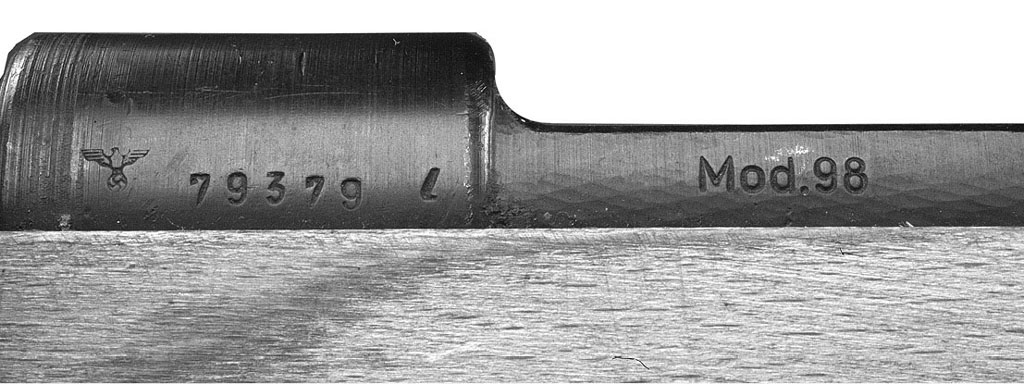

Model 98k


Bayonet for 98k WWII Version

Courtesy Buffalo Bill Historical Center, Cody, Wyoming
Exc. |
V.G. |
Good |
Fair |
1500 |
850 |
600 |
350 |
Model 98k Carbine (Short Rifle) Russian Capture
Mauser 98ks captured by Russia during WWII. They re-worked and refinished them after the war. Few will have any originally matching parts. The bolt and some major parts were re-numbered to match the receiver with an electric pencil by the Russians. The Nazi era markings are usually intact. Sometimes the swastikas were removed by the Russians or other nations that re-used the 98k.
Exc. |
V.G. |
Good |
Fair |
500 |
350 |
250 |
200 |
Bayonet for 98k (84/98) WWII Version
The standard bayonet for the K98k Mauser rifle. Smooth wood grips are found on early examples. Later production has composite grips. The 9.8" single edge blade has a blued or phosphate finish. Made by several contractors. Wartime production has a manufacturers code and a two digit date. Usually has a serial number on the ricasso and scabbard. They seldom are found that match. Collectors will pay up to a 100 percent premium for matching specimens or rare makers and dates. Price range 250 – 50.
Model 98k Carbine (Short Rifle with extended magazine)
This model is a 98k with a non-removable 25-round magazine. It was an attempt to solve the problem of the limited magazine capacity of the standard 98k. This magazine could be filled singly or with 5-round clips.

Courtesy Amoskeag Auction Company
NOTE: Beware of after-factory add-ons. Prices listed below are for verifiable examples.
Exc. |
V.G. |
Good |
Fair |
5000 |
3500 |
3000 |
1800 |
Model 1916 Self-Loading Flyer’s Rifle
First built in 1916 by Mauser at Oberndorf, this is a semi-automatic recoil operated rifle chambered for the 7.92×57mm cartridge. Fitted with a 26-inch barrel. Some sources list the magazine capacity at 25 rounds, others at 20 rounds. The magazine is slightly curved. Weight of rifle is about 10.5 lbs. The rifle was issued with 10 magazines. It is estimated that somewhere between 1,000 and 2,000 were produced. The rifle was designed to be used by airborne gunners during WWI. Very Rare.
Exc. |
V.G. |
Good |
Fair |
25000 |
20000 |
17500 |
12000 |
DSM 34 Training Rifle
A single shot rifle chambered for .22LR. Resembles a K98k Mauser. Introduced in the 1930s and used for training by various German government and para military organizations. Made by several companies including: Mauser, Walther, Geco, BSW, Erma and Simson. Most have the bolts serial numbered to the rifle.
Note: there is a large variety of variations of these .22 Trainers. Each company that produced the DSM 34 pattern rifles used their own action design. Some makers and variations will command higher prices from collectors. This entry is for the military stocked models only. There are also many different sporter-stocked .22s that are generally worth less. See Mauser Smallbore Trainers by Collector Grade Publications for very detailed information about these training rifles.
Exc. |
V.G. |
Good |
Fair |
1250 |
900 |
650 |
300 |
ERMA, Erfurt 22 Conversion Unit for K98k Mauser
This includes a .22LR barreled action that installs in the standard K98k. Uses a 7-round detachable magazine. Issued in a wooden storage case. Deduct 25% if no case.

ERMA, Erfurt 22 Conversion Unit for K98k Mauser
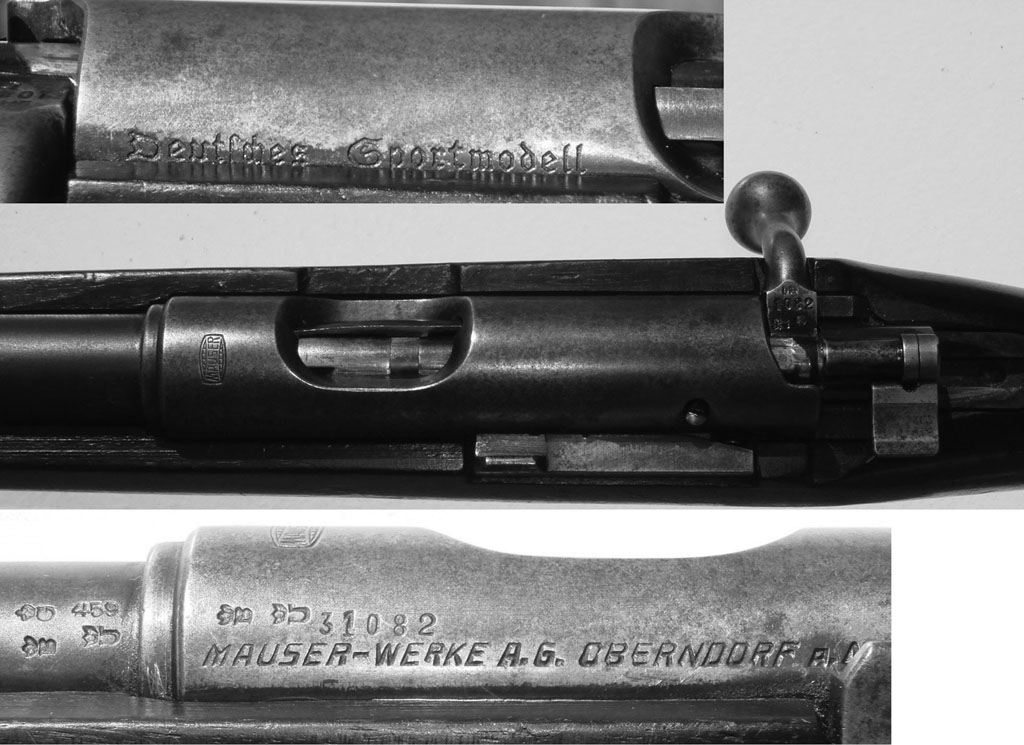
Mauser DSM-34 .22LR action
Exc. |
V.G. |
Good |
Fair |
1000 |
850 |
700 |
400 |
The German sniper rifle used the K98k rifle as its foundation from 1914 to the end of WWII, although other models such as the G41 and G43 were as employed in that role later in World War II. To simplify a somewhat complex subject, German Sniper rifles are separated into five distinct types. These varieties are based on the type of telescope sight used on the rifle.
Different systems were used at different times and often overlap each other. Each system has its own varieties of telescopes made by different manufacturers. Some scopes are numbered to the rifle while others are not. Some rifles and scopes bear the markings of the Waffen-SS, and these will bring a premium.


Mauser 98k with high turret scope • Private Collection, Paul Goodwin photo


Mauser 98k Short Rail Sniper Rifle • Courtesy Amoskeag Auction Company
There were a number of different manufacturers of sniper scopes during the period between 1914 and 1945, and each of these manufacturers was assigned a production code. For example, Schneider & Co. was “dkl”. These codes and other pertinent information, including historical information, data, and photos, can be seen in The German Sniper, 1914-1945, Peter R. Senich, Paladin Press, 1982.
NOTE: Prices listed below are for the rifle and the correct scope and base, i.e. verifiable examples. Sometimes the scope and base are not numbered. It is recommended that an expert opinion be sought before purchase. It should be noted that the prices for German sniper rifles are subject to variations with different scope and mount combinations. Proceed with caution.
Model 98k Sniper Rifle (High Turret Model)
A sniper version of the 98k with different manufactured scopes. This variation has a 6.35mm recess depth greater in the front base cone than the low turret mount. Thus the distinguishing feature in these sniper rifles is the mount, although high-quality German-made scopes will bring a premium.
Exc. |
V.G. |
Good |
Fair |
12500 |
7500 |
5000 |
2000 |
Model 98k Sniper Rifle (Low Turret Model)
As above but with a lower front base cone than the high turret mount.

Courtesy Rock Island Auction Company
Exc. |
V.G. |
Good |
Fair |
12500 |
7500 |
5000 |
2000 |
Model K98k Sniper Rifle (Short Rail System)
This mounting system was originally intended for police use during the mid-1930s. Beginning in 1941 this mounting was adopted for general combat use with 98k rifles. Ajack, Zeiss, Hensoldt, and Kahles in 4x are the often-encountered scopes on these mounts. Some of these short rail models were produced specifically for the Waffen-SS and these will command a considerable premium for correctly marked rifles and scopes.
Exc. |
V.G. |
Good |
Fair |
8000 |
5000 |
3000 |
2000 |
Model K98k Sniper Rifle (Long Rail System)
This mounting system was not utilized in the German military until 1944. This system required that the 98k rifle be modified by having an enlarged receiver flat machined to accommodate the mounting base. This receiver flat has three large tapped screw holes and two smaller holes for tapered pins. It should be noted that these are very valuable and collectable rifles that are subject to fakes. Consult an expert prior to a purchase.
Exc. |
V.G. |
Good |
Fair |
12500 |
7500 |
5000 |
2000 |
Model K98k Sniper Rifle (Claw Mount System)
According to Senich about 10,000 “bnz” code 98k rifles were produced with claw mounts from late in 1943 to 1944. Various 4× scopes were used on these mounts but the most often encountered is the Hensoldt, Wetzlar (code “bmj”). Original issue rifles will have the rifle, base, and scope with matching numbers.
Exc. |
V.G. |
Good |
Fair |
12500 |
7500 |
5000 |
2000 |
Model K98k Sniper Rifle (ZF41)
This version of the 98k is fitted with a ZF41 scope (1.5×). It is not, in the true sense of the word, a sniper rifle but rather the scope is fitted as an aid to marksmanship. More than 300,000 were produced in this configuration between 1941 and 1945.


Mauser 98k Short Rail Sniper Rifle • Courtesy Amoskeag Auction Company


German “bcd4” Long Rail Sniper. This is the blued variation with flat ground safety • Courtesy Michael Wamsher, Paul Goodwin photo

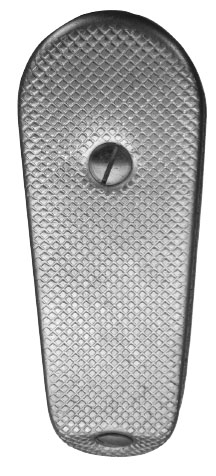

German “bcd4” Long Rail Sniper with later phosphate finish with “key” safety. Note the original checkered butt plate • Courtesy Michael Wamsher, Paul Goodwin photo
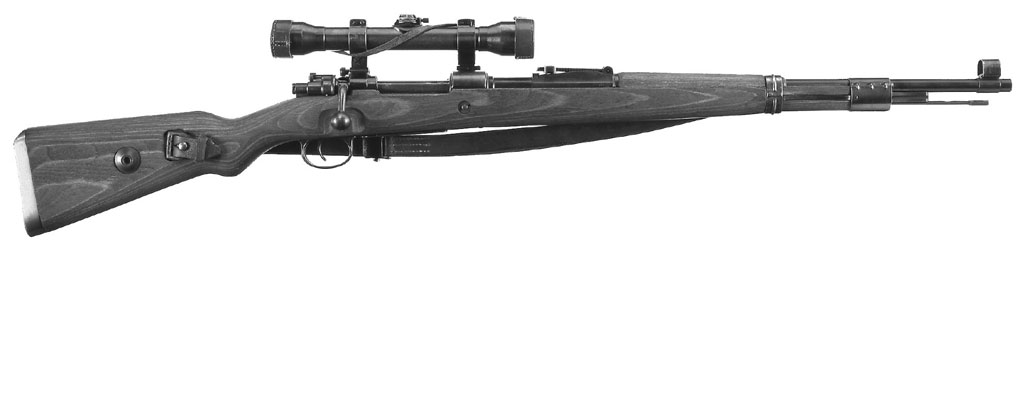

German “bcz” Single Claw Sniper Rifle. Hensold-Wetzar coded “bmj” scope with winter “t” • Courtesy Rock Island Auction Company



Mauser K98k with ZF41 scope • Private Collection, Paul Goodwin photo

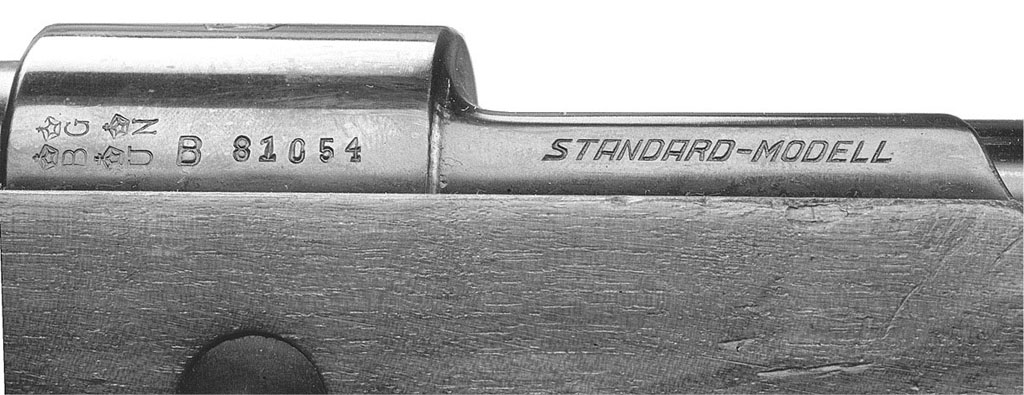

Model 1933 Standard Model • Courtesy West Point Museum, Paul Goodwin photo
Exc. |
V.G. |
Good |
Fair |
3500 |
2500 |
1250 |
750 |
Model K98k Sniper Rifle (Dual Rail)
This sniper version is fitted with a dual rail scope mount. It is estimated that only about 25 of these rifles were built using this sight system.
Exc. |
V.G. |
Good |
Fair |
Too |
Rare |
To |
Price |
Model 1933 Standard Model Short Rifle
Introduced in 1933 and fitted with a 23.6-inch barrel full stock with pistol grip and finger grooves in forend. Short upper handguard. Weight is about 8.75 lbs. Used extensively by the German Condor Legion in the Spanish Civil War, 1936 to 1939. Stamped with Mauser banner on receiver ring with date of manufacture.
Exc. |
V.G. |
Good |
Fair |
1200 |
900 |
750 |
350 |
Model 1933 Standard Model Carbine
Similar to the Model 98k but forearm has finger grooves. Mauser banner stamped on top of receiver ring with date of manufacture. Weight is about 8.5 lbs.
Exc. |
V.G. |
Good |
Fair |
1500 |
1200 |
800 |
400 |
Model 33/40 Carbine
This carbine was made in Brno in Czechoslovakia during World War II after it was occupied by the German army. This model featured a laminated stock with full upper handguard. Fitted with a 19.2" barrel and marked “G. 33/40” together with the year of production and the maker’s code. Marked “dot” over the date or “945” over the date. Weight is about 8 lbs.

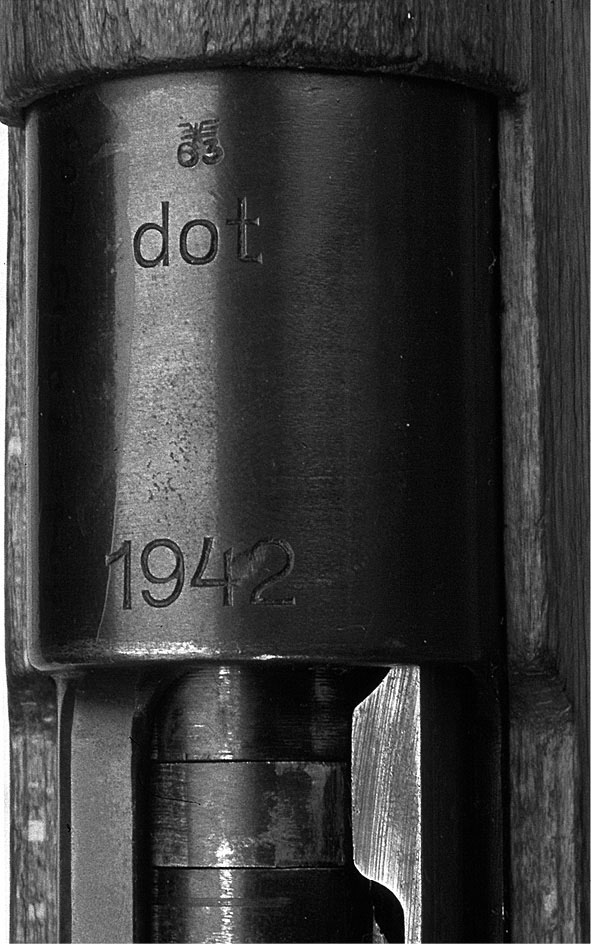
Model 33/40 • Courtesy West Point Museum, Paul Goodwin photo

Waffen SS and their Gew 33/40 rifles • Courtesy Paul S. Scarlata
Exc. |
V.G. |
Good |
Fair |
1800 |
1200 |
850 |
400 |
Model 29/40 Rifle (G29o)
This rifle was built by Steyr for the German Luftwaffe. It has a bent bolt and an “L” marked stock. There is some confusion over the origins of this model and its correct designations and configurations. Consult an expert prior to a sale.
Exc. |
V.G. |
Good |
Fair |
1000 |
800 |
500 |
300 |
Model 24 (t) Rifle
This is the German version of the Czech VZ24 rifle built during the German occupation of that country during WWII.

Courtesy Rock Island Auction Company
Exc. |
V.G. |
Good |
Fair |
950 |
750 |
500 |
250 |
Model VG-98
These are crude half-stocked 7.92mm weapons produced near the end of the war to arm the German population. Barrel length is about 21inches and some use a 10-round magazine while other examples are single shot. Weight is about 7 lbs. It is made from parts of older, often unserviceable Mausers. Will command premium prices.
Exc. |
V.G. |
Good |
Fair |
9000 |
6000 |
4000 |
1800 |
Model VG-1 (Volksturm Gewehr)
This rifle was made in the last days of WWII and is crudely made. It used the magazine of a semi-automatic Model 43 rifle. Beware of firing this weapon. It is roughly made but because of historical interest and high demand, prices command a premium.
Exc. |
V.G. |
Good |
Fair |
9000 |
7500 |
5500 |
3000 |
Model VG-2
Chambered for the 7.9mm cartridge and fitted with a 10-round G43 magazine. This bolt-action rifle has a 21-inch barrel with no bayonet lug. Cheaply built. Receiver is a “U” shaped stamping. Rare.
Exc. |
V.G. |
Good |
Fair |
9000 |
7500 |
5500 |
3000 |
Model VG-5
Another last-ditch, locally produced rifle made at the very end of World War II. Chambered for the 7.92×33mm Kurz cartridge. Stamped receiver. Magazine is MP44 type. Simply and roughly made.
Exc. |
V.G. |
Good |
Fair |
20000 |
15000 |
10000 |
5000 |
Model 1918 Anti-Tank Rifle
Chambered for the 13×92SR cartridge, this was the first Mauser anti-tank rifle. Barrel length is 39 inches and weight is about 37 lbs. The Mauser banner is stamped on the upper receiver over the date “1918.” Used successfully by the Germans against Allied tanks during WWI.
Exc. |
V.G. |
Good |
Fair |
9000 |
7500 |
5000 |
3500 |

VG-1 Rifle • Courtesy West Point Museum, Paul Goodwin photo

Model 1918 Anti-Tank Rifle • Courtesy Amoskeag Auction Company
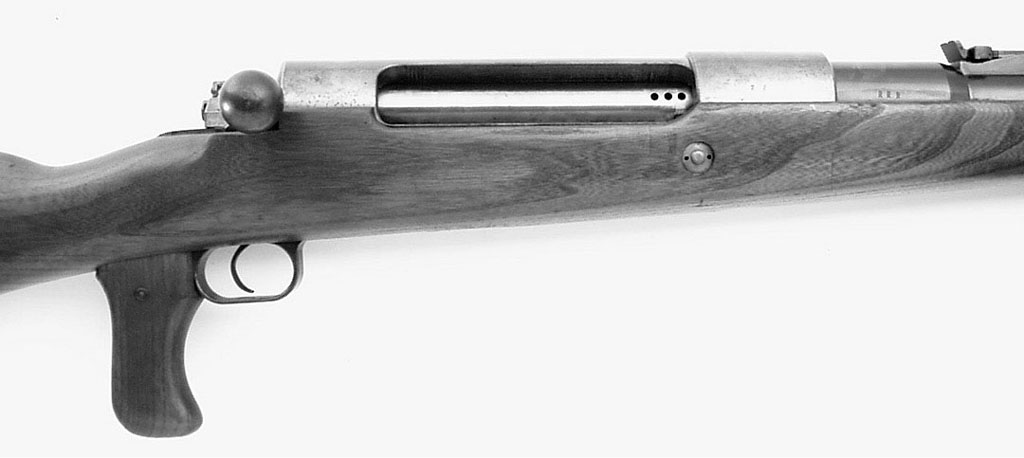
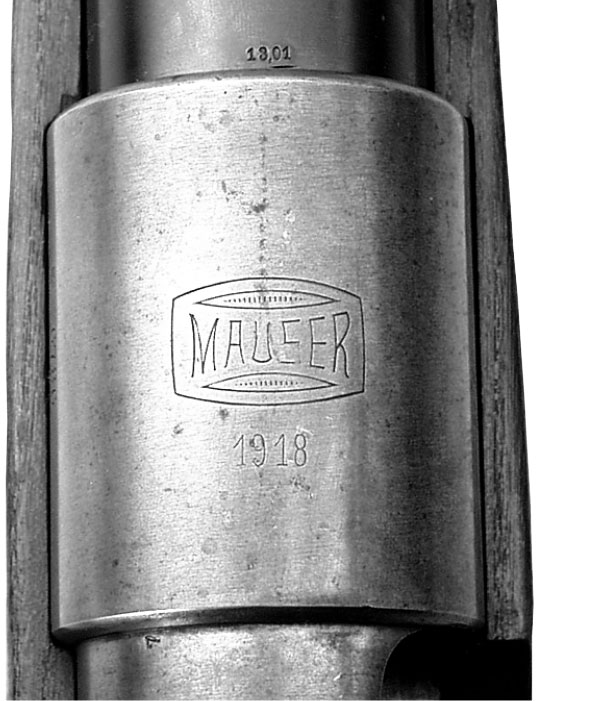
Model G 41 Rifle(M)
First produced in 1941. Built by Mauser (code S42). Not a successful design and very few of these rifles were produced. These are extremely rare rifles today. Chambered for the 7.92mm Mauser cartridge. semi-automatic gas operated with rotating bolt. It was full stocked with a 10-round box magazine. Barrel length is 21.5 inches and weight is about 11 lbs. The total produced of this model is estimated at 20,000 rifles.

Courtesy Richard M. Kumor Sr.
Exc. |
V.G. |
Good |
Fair |
9500 |
8000 |
6500 |
4000 |
Model G 41(W)
Similar to the above model but designed by Walther and produced by “duv” (Berlin-Lubeck Machine Factory) in 1941. This rifle was contracted for 70,000 units in 1942 and 1943. Correct examples will command a premium price.

Courtesy Richard M. Kumor Sr.
Exc. |
V.G. |
Good |
Fair |
7500 |
5000 |
4000 |
3000 |
Model G 43(W) (K43)
An improved version of the G 41(W), introduced in 1943, with a modified gas system that was the more typical gas and piston design. Built by Carl Walther (code “ac”). Full stocked with full-length handguard. Laminated Wood stock. Receiver has a dovetail for telescope sight on the right side. Barrel length is 22 inches and magazine capacity is 10 rounds. Weight is approximately 9.5 lbs. It is estimated that some 500,000 of these rifles were produced. Used by German sharpshooters during World War II and also by the Czech army after WWII.
Exc. |
V.G. |
Good |
Fair |
2500 |
1750 |
1000 |
800 |
Model G 43(W) (K43) Sniper Rifle
A G-43 or K-43 issued with a ZF-4 scope and mount.
Exc. |
V.G. |
Good |
Fair |
6000 |
5000 |
4000 |
3000 |
Model FG 42 (Fallschirmjager Gewehr)
This select fire 7.92×57mm rifle was adopted by the Luftwaffe for its airborne troops. It was designed to replace the rifle, light machine gun, and submachine gun. It incorporates a number of features including straight line stock and muzzle brake, reduced recoil mechanism, closed-bolt semi-automatic fire, and open-bolt full-auto fire. Rate of fire is about 750 rounds per minute. It had a mid-barrel bipod on early (1st Models, Type “E”) models and front mounted barrel bipod on later (2nd Models, Type “G”) models. Barrel attachment for pike-style bayonet. First Models were fitted with steel buttstocks, sharply raked pistol grips, and 2nd Models with wooden stocks and more vertical pistol grips. The 20-round magazine is left side mounted. Fitted with a 21.5-inch barrel, the rifle weighs about 9.5 lbs. This breech mechanism was to be used years later by the U.S. in its M60 machine gun.

K43 Sniper Rifle • Courtesy Rock Island Auction Company

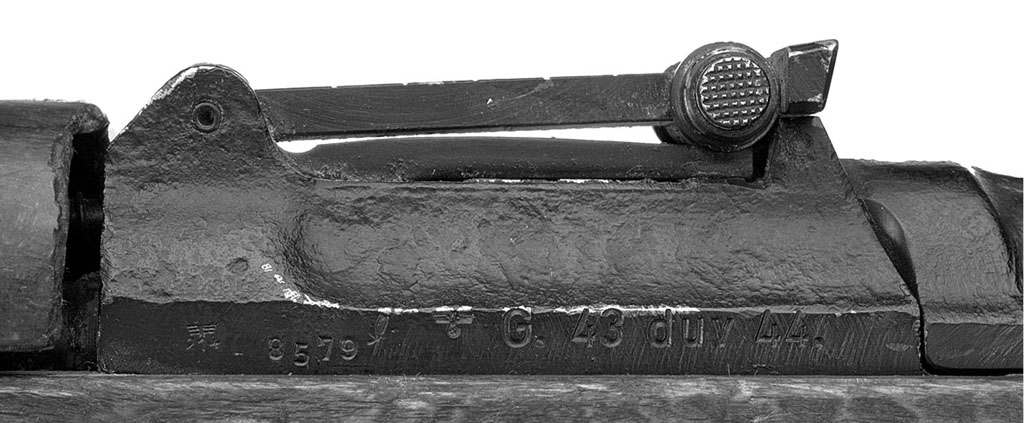
Model G 43 left side with receiver markings, note rough finish • Paul Goodwin photo

Model G 43(W) • Courtesy Rock Island Auction Company



FG 42 with original German FG 42 ZF 4 scope and without scope and wooden buttstock • Private Collection, Paul Goodwin photo
Pre-1968
Exc. |
V.G. |
Fair |
45000 |
35000 |
25000 |
NOTE: For rifles fitted with original German FG 42 scopes add between $5,000 and $10,000 depending on model. Consult an expert prior to a purchase.
Because the German military thought the 7.92×57mm cartridge too powerful for its needs, a new cartridge was developed to provide less recoil, lighter weight, and less expensive production. This new cartridge, developed in the mid 1930s by Gustav Genschow, Polte, and others, was called the 7.92×33mm Kurtz (Short) cartridge. The entire cartridge was 1.89 inches in length and had a bullet weight of 125 grains. This new cartridge was introduced in 1943 and spawned a new series of firearms designed for that cartridge.
Bibliographical Note: For a complete and exhaustive account of the Sturmgewehr rifles see Hans-Dieter Handrich’s Sturmgewehr: From Firepower to Striking Power, Collector Grade Publications, 2004.
MKb42(W)
This select-fire open bolt machine carbine built by Walther was used on the Russian front. It was fitted with a 30-round box magazine and 16-inch barrel. Rate of fire was about 600 rounds per minute. It was fitted with a wooden stock and metal forearm. The rest of the weapon, with the exception of the barrel and bolt, was made from sheet metal to save cost and weight. Weight was about 9.75 lbs. A total of about 8,000 of these weapons were built by Walther. This model was not selected by the German Army because, according to Handrich’s book, the front sight was too wide, and covered the target at 300m. The construction was too complex, which resulted in lack of reliability. Trigger pull was excessive for accurate fire.
Pre-1968 (Very Rare)
Exc. |
V.G. |
Fair |
25000 |
18500 |
15000 |


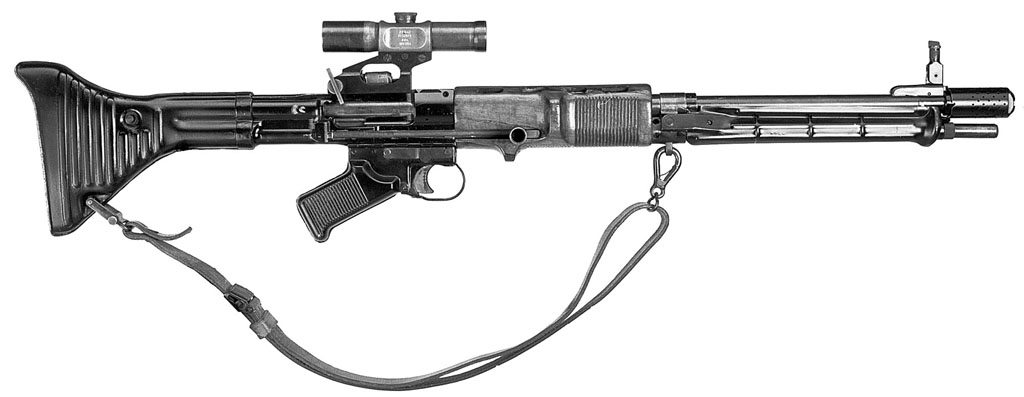
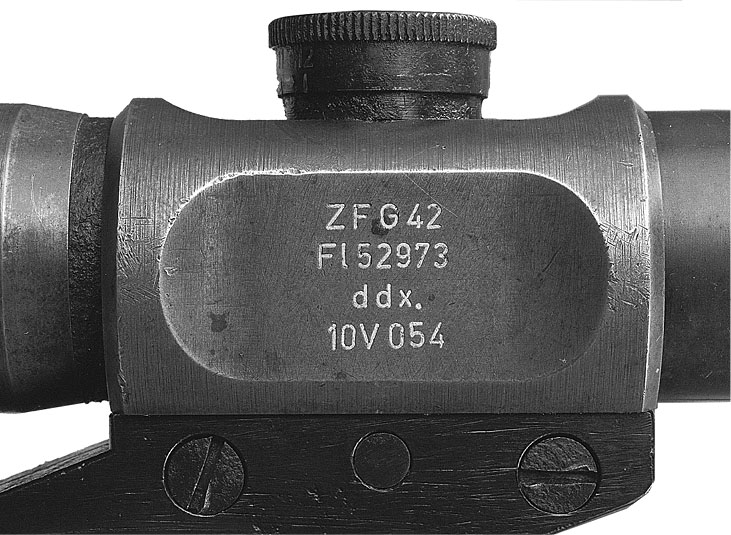
FG 42 with original German ZFG 42 scope and steel buttstock • Courtesy private NFA collection, Paul Goodwin photo


MKb42(W) • Courtesy West Point Museum, Paul Goodwin photo

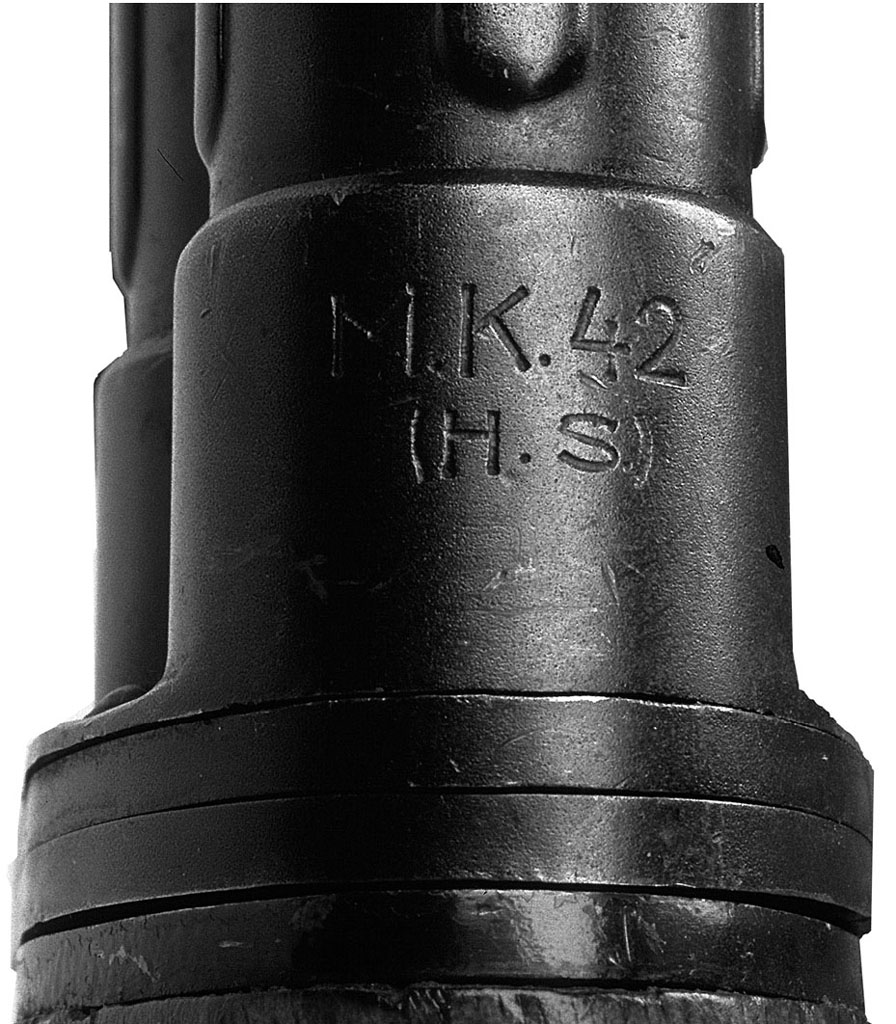
MKb42(H) • Courtesy West Point Museum, Paul Goodwin photo
MKb42(H)
This was a design similar to the Walther version (open bolt) except for a 14.5-inch barrel and other internal differences. It was built by Haenel, and also saw extensive use on the Eastern Front. This version proved to be better than the Walther design. Its rate of fire was a somewhat slower 500 rounds per minute. Weight was approximately 11 lbs. Some 8,000 of these weapons were also produced. Handrich states that the advantages of the Haenel model were simple, reliable construction, greater sight radius for more accurate fire, good front sight, and uniform trigger pull.
NOTE: Some MKb42(H) rifles had bayonet lugs while others did not. All of these rifles were fitted with mounting rails for a telescope sight.
Pre-1968
Exc. |
V.G. |
Fair |
25000 |
18500 |
12500 |

MP43 • Paul Goodwin photo

DEWAT MP44 • Courtesy Amoskeag Auction Company
MP43, MP43/1
With some redesign this model was a newer MKb42(H). This weapon was adopted by the Waffenamt as standard issue in 1944. Originally built by Haenel, it was later produced by Mauser and Erma. This model was the forerunner of the MP44 and StG44. The MP43 had a stepped barrel while the MP43/1 had a straight barrel.
Pre-1968
Exc. |
V.G. |
Fair |
18500 |
14500 |
9500 |
Pre-1986 manufacture with new receiver or re-weld
Exc. |
V.G. |
Fair |
7500 |
5500 |
4000 |
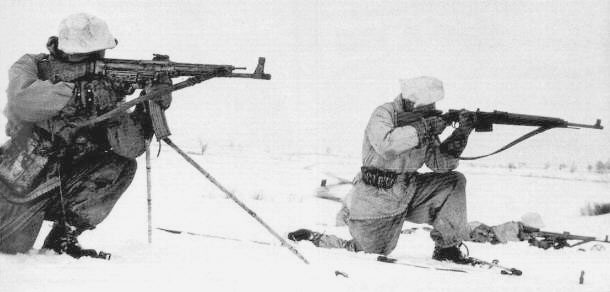
Stg44 & G43 in combat • Courtesy Paul S. Scarlata
MP44
This German automatic rifle was first produced in 1943 and chambered for the 7.92×33 Kurz cartridge. Fitted with a solid stock and 16.3" barrel, it has a magazine capacity of 30 rounds. The rate of fire is 500 rounds per minute. Weight is about 11.5 lbs. Marked “mp44” on top of the receiver. Production ceased in 1945. This rifle was used extensively on the Eastern Front during World War II.
Pre-1968
Exc. |
V.G. |
Fair |
18500 |
15000 |
13000 |
Pre-1986 manufacture with new receiver or re-weld
Exc. |
V.G. |
Fair |
7500 |
6500 |
5500 |
StG44
This version of the MP43-MP44 series is nothing more than a name change from the MP44.
Pre-1968
Exc. |
V.G. |
Fair |
18500 |
15000 |
12500 |
Pre-1986 manufacture with new receiver or re-weld
Exc. |
V.G. |
Fair |
7500 |
6500 |
5000 |
Model 86 SR
Introduced in 1993, this bolt action 7.62 NATO is sometimes referred to as the Specialty Rifle. Fitted with a laminated wood and special match thumbhole stock or fiberglass stock with adjustable cheekpiece. Stock has rail in forearm and an adjustable recoil pad. Magazine capacity is 9 rounds. Finish is a non-glare blue. The barrel length with muzzle brake is 28.8 inches. Many special features are found on this rifle, from adjustable trigger weight to silent safety. Mauser offers many options on this rifle as well that will affect the price. Weight is approximately 11 lbs.
NIB |
Exc. |
V.G. |
Good |
Fair |
3300 |
3000 |
2500 |
1750 |
1250 |
Model 93 SR
Introduced in 1996, this is a tactical semi-automatic rifle chambered for the .300 Win. Mag. or the .338 Lapua cartridge. Barrel length is 25.5 inches with an overall length of 48.4 inches. Barrel is fitted with a muzzle brake. Magazine capacity is 6 rounds for .300 and 5 rounds for .338 caliber. Weight is approximately 13 lbs.
NIB |
Exc. |
V.G. |
Good |
Fair |
N/A |
— |
— |
— |
— |
HK G3

Courtesy Heckler & Koch
First adopted by the German army in 1959. Chambered for the 7.62×51mm cartridge and fitted with a 17.5-inch barrel. Solid wooden stock on early models and plastic stock on later models (A3). Folding stock (A2) also offered. Magazine capacity is 20 rounds with a rate of fire of 550 rounds per minute. Weight is about 9.7 lbs. Marked “G3 HK” on left side of magazine housing. This select-fire rifle has seen service with as many as 60 military forces around the world. There are several variations of this model.

Bayonet for G-3/HK-91 Series
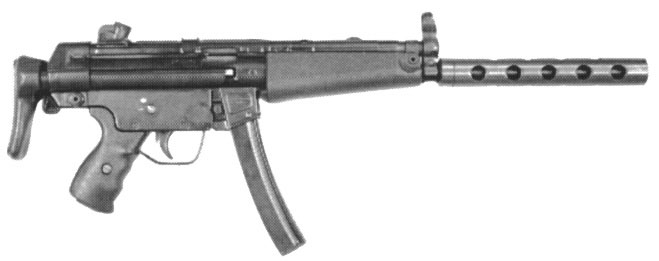
Model 94
Pre-1968
Exc. |
V.G. |
Fair |
15000 |
14000 |
9000 |
Pre-1986 conversions of semi-automatic version
Exc. |
V.G. |
Fair |
8500 |
7500 |
7000 |
Bayonet for G-3/HK-91 series
Ribbed round plastic handle. Latch stud in back of pommel inserts into the plug adapter below the front sight. Muzzle ring. 6.5-inch double edge blade. Plastic scabbard with simulated wood grain appearance. Price range 150 – 50.
Model 91
This rifle is recoil-operated, with a delayed-roller lock bolt. It is chambered for the .308 Winchester cartridge and has a 17.7-inch barrel with military-style aperture sights. It is furnished with a 20-round detachable magazine and is finished in matte black with a black plastic stock. This model is a semi-automatic version of the select fire G3 rifle.
Exc. |
V.G. |
Good |
Fair |
2750 |
2300 |
1550 |
1200 |
Model 91 A3
This model is simply the Model 91 with a retractable metal stock.

Exc. |
V.G. |
Good |
Fair |
3000 |
2500 |
1600 |
1300 |
Model 93
This model is similar to the Model 91 except that it is chambered for the .223 cartridge and has a 16.4-inch barrel. The magazine holds 25 rounds, and the specifications are the same as for the Model 91. This is a semi-automatic version of the select fire HK33 rifle.
Exc. |
V.G. |
Good |
Fair |
2750 |
2300 |
1500 |
1200 |
Model 93 A3
This is the Model 93 with the retractable metal stock.

Exc. |
V.G. |
Good |
Fair |
3000 |
2500 |
1650 |
1300 |
Model 94
This is a carbine version chambered for the 9mm Parabellum cartridge, with a 16.5" barrel. It is a smaller-scaled weapon that has a 15-shot magazine.
Exc. |
V.G. |
Good |
Fair |
3850 |
3300 |
2750 |
2200 |
Model 94 A3
This model is a variation of the Model 94 with the addition of a retractable metal stock.
Exc. |
V.G. |
Good |
Fair |
3900 |
3400 |
2900 |
2300 |
HK 33
This model is a reduced caliber version of the standard HK G3. First produced in 1968 this model is chambered for the 5.56×45mm NATO cartridge (.223 caliber). This rifle is available in several variants, namely a sniper version with set trigger, telescope sight and bipod; a retractable stock version (A3); and a carbine version (12.68"). The HK 33 features a 15.35-inch barrel without flash hider, and a magazine capacity of 25 or 40 rounds. The rate of fire is 750 rounds per minute. The rifle is marked “HK 33 5.56MM” with serial number on the left side of the magazine housing. The rifle is still in production and is in service in Chile, Brazil, various countries in southeast Asia, and Africa. Weight is approximately 8 lbs. for standard model.


HK 33 K • Courtesy Heckler & Koch

Model 94 A3
Pre-1968
Exc. |
V.G. |
Fair |
18500 |
15000 |
12000 |
Pre-1986 conversions of semi-automatic version
Exc. |
V.G. |
Fair |
8500 |
8000 |
N/A |
NOTE: The HK 33 K is the same as the HK 33 with the exception of a 13" barrel. Prices may differ slightly for the HK 33 K version.
HK G41
First produced in 1983, this 5.56×45mm chambered select-fire rifle is fitted with a 17.5-inch barrel and has a magazine capacity of 30 rounds. Rate of fire is about 850 rounds per minute. Marked “HK G41 5.56MM” on the left side of the magazine housing. This model will accept M16 magazines. This model is also available with fixed or retractable stock. Weight is 9.7 lbs. No known examples in the U.S.

HK G41 • Courtesy Heckler & Koch
Pre-1968
Exc. |
V.G. |
Fair |
N/A |
N/A |
N/A |
PSG-1
This rifle is a high-precision sniping rifle that features the delayed-roller semi-automatic action. It is chambered for the 7.62 NATO (.308 Winchester) cartridge and has a 5-shot magazine. Barrel length is 25.6 inches. It is furnished with a complete array of accessories including a 6×42-power illuminated Hensoldt scope. Rifle weighs 17.8 lbs.
NIB |
Exc. |
V.G. |
Good |
Fair |
14500 |
12500 |
9000 |
7500 |
6000 |
Luftwaffe Survival Drilling
A double-barrel 12 gauge by 9.3×74R combination shotgun/rifle with 28-inch barrels. Blued with a checkered walnut stock and marked with Nazi inspection. Stampings on the stock and barrel breech. Normally furnished with an aluminum case.

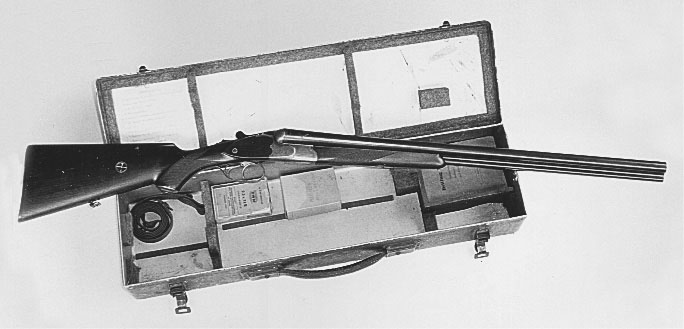
Courtesy Richard M. Kumor Sr.

Model PSG-1
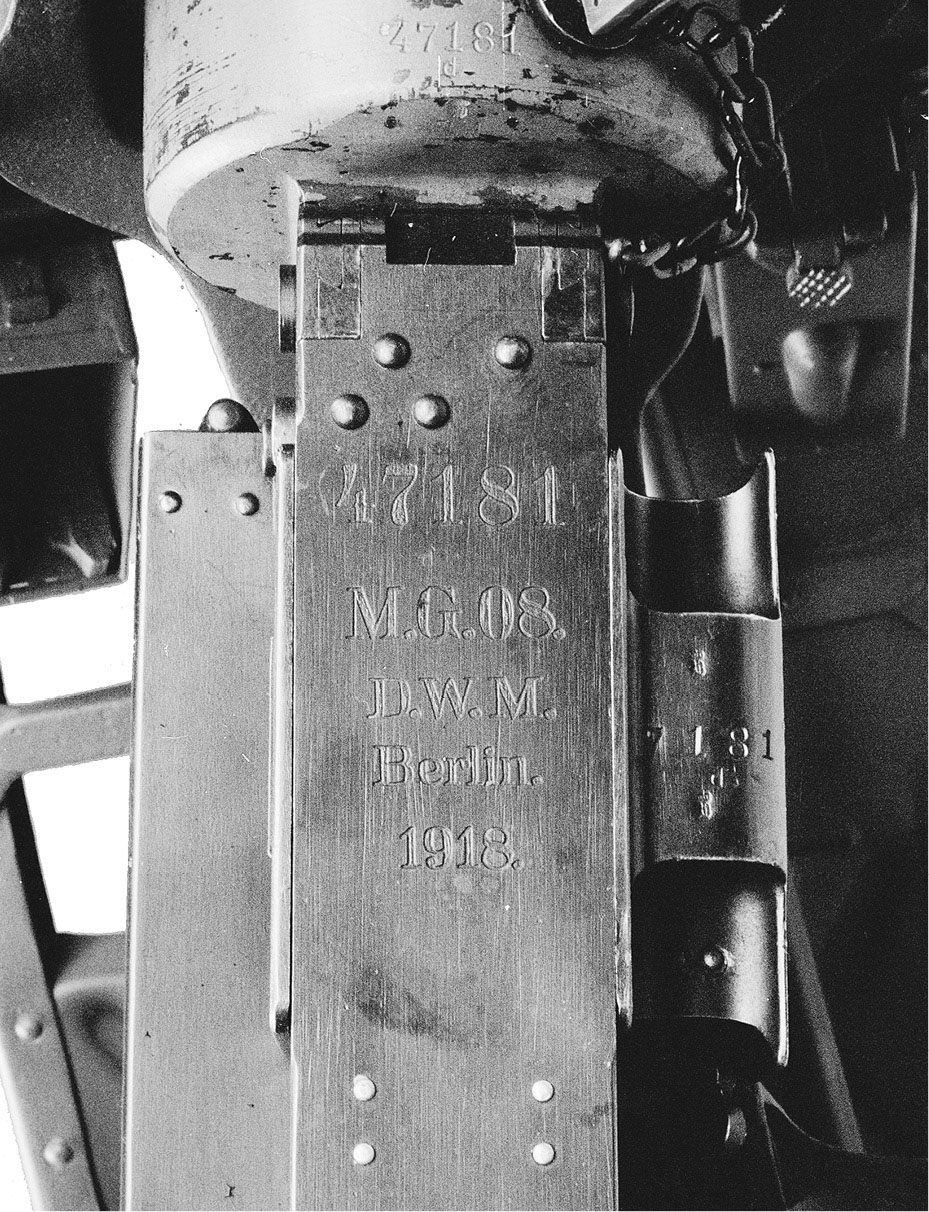
Exc. |
V.G. |
Good |
Fair |
6000 |
5500 |
3800 |
2500 |
NOTE: Add 50 percent to prices for case.
Germany adopted the Maxim gun and designated it the MG 01, which was built on the Belgian Maxim pattern Model 1900. It was not until 1908 that Germany produced its own version of the Maxim called the MG 08.
Bibliographical Note: For information on a wide variety of German machine guns, see Daniel D. Musgrave, German Machineguns, 2nd edition, Ironside International Publishers, 1992. Also Folke Myrvang, MG 34-MG42, German Universal Machineguns, Collector Grade Publications, 2002. Dolf L. Goldsmith, The Devil’s Paintbrush, (the Maxim Gun) Collector Grade Publications, 2002.
Maxim ’08 (MG 08)
Germany adopted this gun at the turn of the 20th century. In 1908 they began to produce the gun themselves. This was the standard German heavy machine gun during WWI. Chambered for the 7.92×57mm cartridge this gun had a rate of fire of 400 to 500 rounds per minute from its 28-inch barrel. It was fed with a 100- or 250-round fabric belt. The gun weighed about 41 lbs. with a sled mount weighing about 83 pounds. The gun was marked “deutche waffen und munitionsfabriken berlin” with the year of production on the left side of the receiver. The serial number was located on the top of the receiver. The gun was produced from 1908 to about 1918.

Maxim ‘08 • Courtesy private NFA collection, Paul Goodwin photo


MG 08/15 • Courtesy West Point Museum, Paul Goodwin photo

MG 08/15 September 1939 in Poland • Courtesy Blake Stevens, The Devil’s Paintbrush, Collector Grade Publications
Pre-1968
Exc. |
V.G. |
Fair |
25000 |
18000 |
15000 |
Pre-1986 manufacture with new side plate
Exc. |
V.G. |
Fair |
15000 |
10000 |
N/A |
Maxim ’08/15
A more movable version of the Maxim Model ’08. Chambered for the 7.92×57mm Mauser cartridge and fitted with a 28-inch water-cooled barrel with bipod, it weighs about 31 lbs. It is fed by a 100-round cloth belt housed inside of a special drum with a rate of fire of 500 rounds per minute. Marked “LMG 09/15 SPANDAU” on top of the receiver. Spandau produced 50,000 guns.
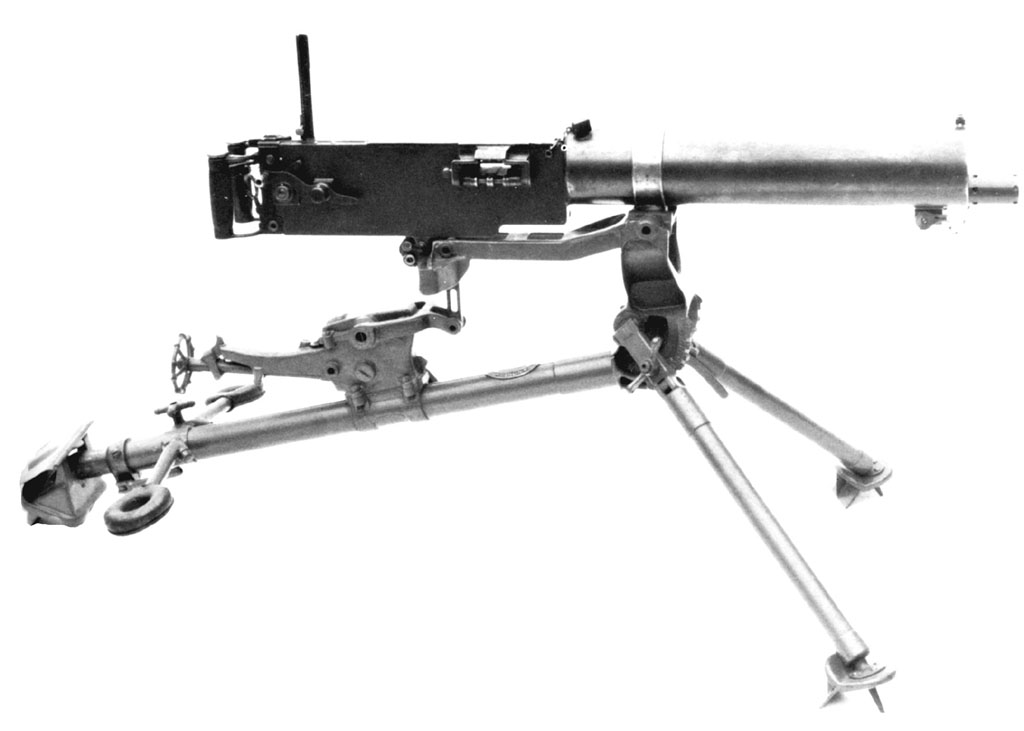
Maxim 1909 Commercial • Courtesy Blake Stevens, The Devil’s Paintbrush, Goldsmith


Dreyse Model 1915 • Courtesy private NFA collection, Paul Goodwin photo
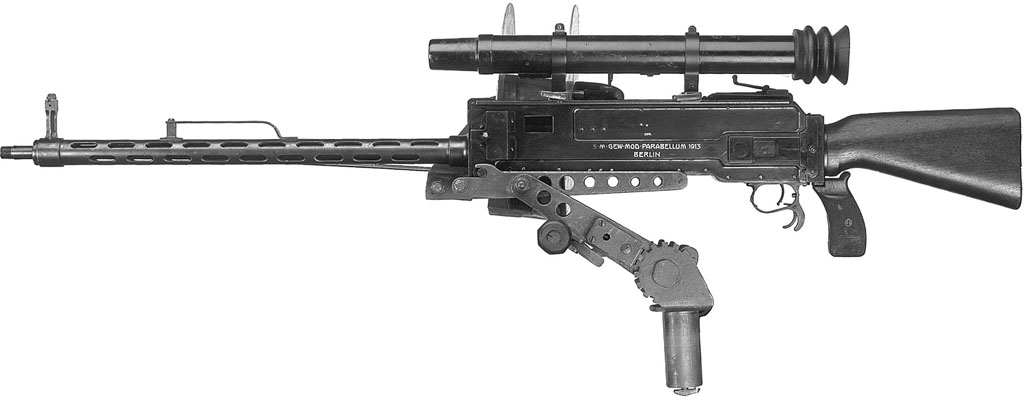


Parabellum with original scope • Courtesy private NFA collection, Paul Goodwin photo
Other manufacturers of the gun were:
Nurnburg (M.A.N.)–14,000
Another version of this gun with an air-cooled slotted barrel jacket was used in aircraft and was called the IMG 08/15.
Pre-1968
Exc. |
V.G. |
Fair |
18500 |
15000 |
12000 |
Pre-1986 manufacture with new receiver or re-weld
Exc. |
V.G. |
Fair |
12500 |
10000 |
N/A |
Model 1909
A DWM commercial version of the Model 1908 built for export. Fitted with a muzzle booster. Some were sent to Costa Rica as well as Brazil, Mexico, Romania, Switzerland, Belgium, China, and Persia. Some of these countries, like Switzerland and China, built their own military versions of the DWM 1909 commercial. A seldom-seen variation.
Pre-1968
Exc. |
V.G. |
Fair |
22500 |
18000 |
12500 |
Pre-1986 manufacture with new receiver or re-weld
Exc. |
V.G. |
Fair |
15000 |
11500 |
10500 |
Dreyse Model 1910/15
Chambered for the 7.92×57mm Mauser cartridge, this gun was based on the Louis Schmeisser patents of 1907. Built by Rheinmetall in Sommerda, Germany. Named in honor of Johann Niklaus von Dreyse who died in 1875. This is a water-cooled gun designed for sustained fire. Rate of fire is about 550 to 600 rounds a minute. Weight is approximately 37 lbs. Most of these guns were converted by Germany to MG 13s during the 1930s, so few original Dreyse models still survive. Very rare in unaltered condition.
Pre-1968
Exc. |
V.G. |
Fair |
28000 |
25000 |
20000 |
Parabellum MG 14
Chambered for the 7.9mm cartridge, this was a water-cooled light machine gun. There was also an air-cooled version with a slotted water jacket. Barrel length is 27.75 inches. Rate of fire is about 700 rounds per minute. Weight is about 21.5 lbs. This gun was derived from the Maxim but the main spring is located behind the receiver and is compressed during recoil. The gun was much lighter than the Maxim. Also, the Parabellum has no dead stop on the crank handle. The gun was the standard observer’s machine gun in German two-seat aircraft during World War I. The gun was also used in Zeppelins as well as a ground gun. Built by DWM.

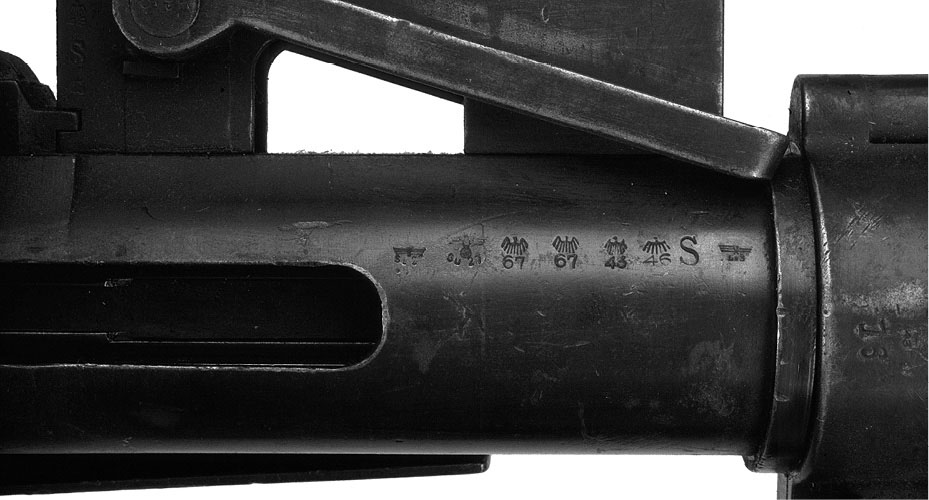

MG 13 • Courtesy West Point Museum, Paul Goodwin photo
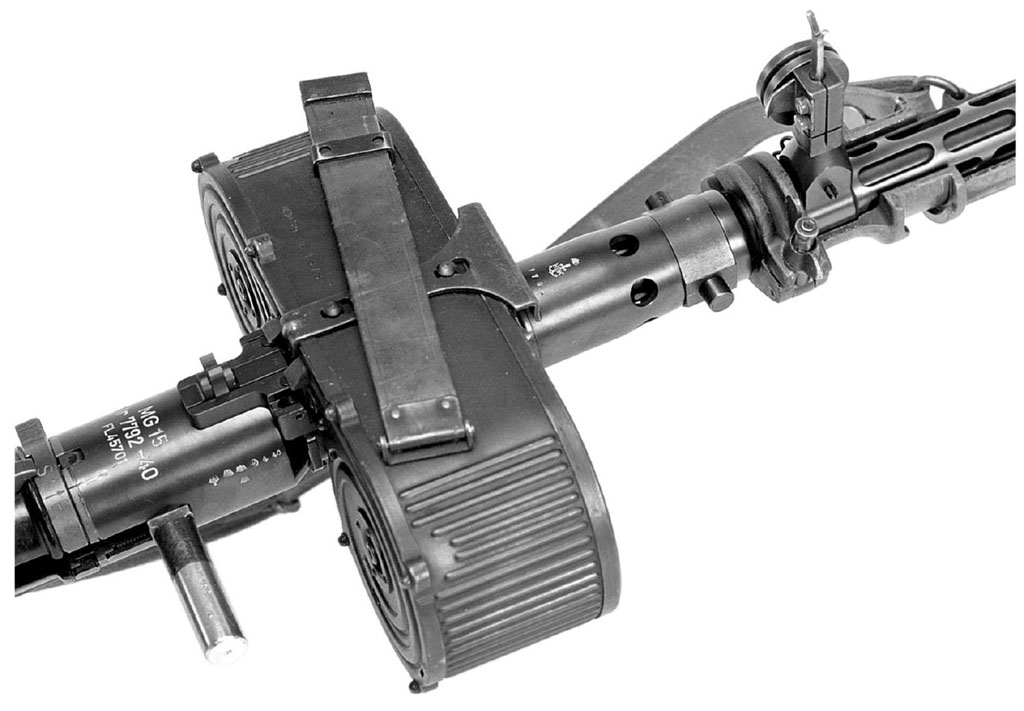
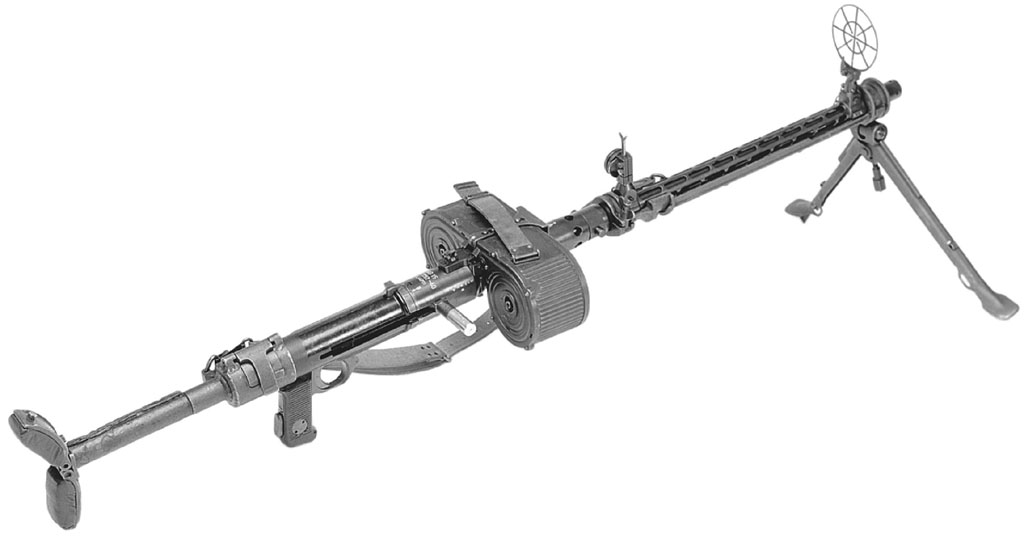
MG15 Air-Cooled Ground Gun • Courtesy private NFA collection, Gary Gelson photo

Private NFA collection, Gary Gelson photo
Pre-1968
Exc. |
V.G. |
Fair |
Too Rare To Price.
MG 13
In 1932 the German army adopted the MG 13 as its standard machine gun. Chambered for the 7.92×57mm cartridge and fitted with a 28-inch air-cooled barrel, this gun is recoil operated. The butt is a single arm metal type with pistol grip. The bipod is attached close to the muzzle. A 25-round box magazine or a 75-round saddle drum magazine can be used. Weight is about 25 lbs. with bipod. Who manufactured the gun is unclear, but Simson of Suhl, Germany, is often reported to be the manufacturer, perhaps because the company was the only legal machine gun manufacturer under the Versailles Treaty. Evidence suggests that the gun was made at Sommerda by Rheinmetall.

Private NFA collection, Gary Gelson photo
NOTE: The 75-round drum for use with the MG 13 is rare because it uses an MG15 drum with a special magazine extension to fit into the side of the MG 13 magazine well.
Pre-1968
Exc. |
V.G. |
Fair |
22500 |
18500 |
15000 |
Pre-1986 manufacture with new receiver or re-weld
Exc. |
V.G. |
Fair |
15000 |
13000 |
11000 |
MG15 Aircraft Gun
Used by the German air force in its bombers, this air-cooled gun is chambered for the 7.92×57JS cartridge. Rate of fire is about 850 rounds per minute. Barrel length is 28". Saddle drum magazine with 75-round capacity was used. Weight is about 28 lbs. Built by Krieghoff. Made by Rheinmetall beginning in 1932.
Pre-1968
Exc. |
V.G. |
Fair |
20000 |
18000 |
16500 |
Pre-1986 manufacture with new receiver or re-weld
Exc. |
V.G. |
Fair |
15000 |
13000 |
12000 |
MG15 Water-Cooled Ground Gun
A converted aircraft machine gun, this water-cooled model was used by ground forces from 1944 to 1945. Barrel length was 30 inches and weight is about 33 lbs. Chambered for the 7.92×57JS cartridge. Rate of fire is about 750 rounds per minute. Ammunition capacity is a 75-round saddle drum magazine. Built by Krieghoff.
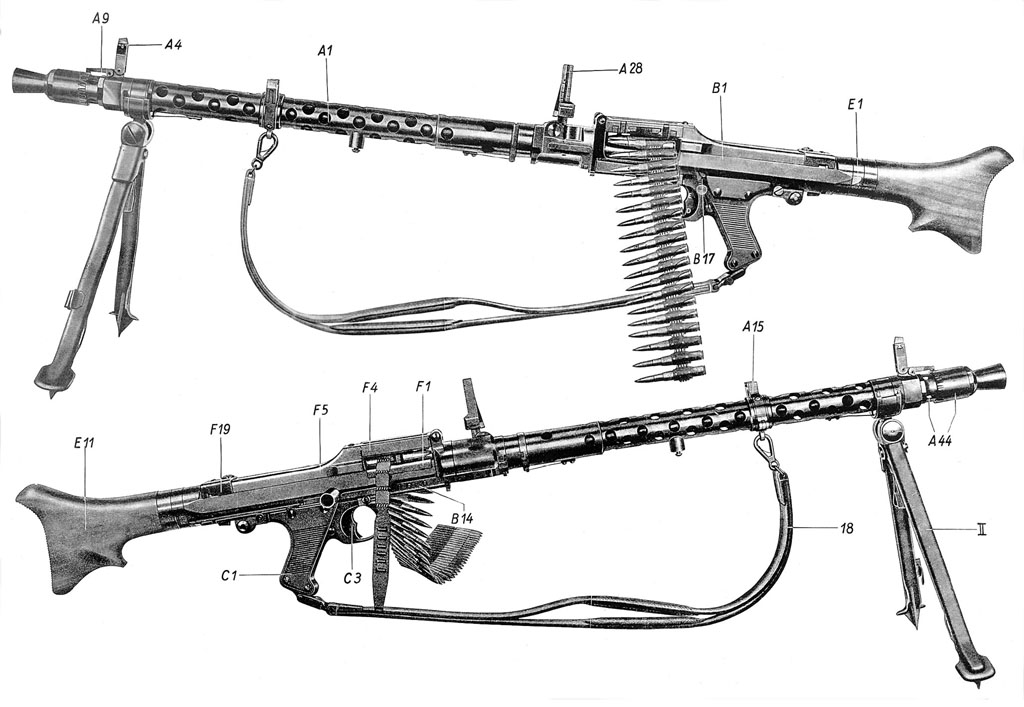
MG34 • Courtesy Blake Stevens, MG34-MG42 German Universal Machine Guns, Myrvang
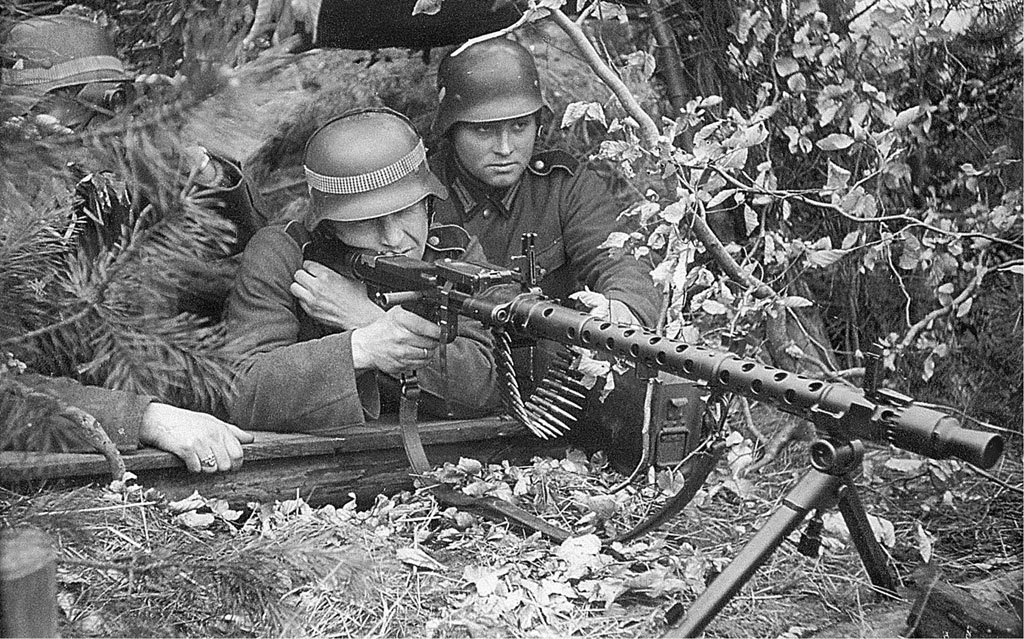
MG34 in action • Courtesy Blake Stevens, MG34-MG42 German Universal Machine Guns, Collector Grade Publications

MG34 with receiver markings • Paul Goodwin photo


Pre-1968
Exc. |
V.G. |
Fair |
22500 |
18000 |
15000 |
Pre-1986 manufacture with new receiver or re-weld
Exc. |
V.G. |
Fair |
15000 |
13000 |
12000 |
MG15 Air-Cooled Ground Gun
Same as the aircraft gun but converted to ground use in 1944 and 1945 by attaching a bipod and single strut buttstock.
Pre-1968
Exc. |
V.G. |
Fair |
25000 |
23000 |
21500 |
Pre-1986 manufacture with new receiver or re-weld
Exc. |
V.G. |
Fair |
22000 |
20000 |
18500 |
MG34
Designed and built by Mauser, this was the first general purpose machine gun to be produced in large numbers. It was introduced into the German army in about 1936, and stayed in production until the end of the war in 1945. Chambered for the 7.92×57mm Mauser cartridge, this gun had a 25-inch barrel with a 50-round belt or 75-round saddle drum. Rate of fire was about 800 to 900 rounds per minute. Marked “MG34” with its serial number on top of the receiver. Weight was approximately 26.5 lbs. There were a number of different bipod and tripod mounts for this gun, as well as different gun configurations such as antiaircraft use, use in armored vehicles, and one configuration where only automatic fire was possible. After WWII the gun was used by the Czechs, French, and Israelis, as well as the Viet Cong. Superseded by the MG42.
Pre-1968
Exc. |
V.G. |
Fair |
38000 |
35000 |
30000 |
Pre-1986 manufacture with new receiver or re-weld
Exc. |
V.G. |
Fair |
25000 |
22500 |
20000 |
MG42-MG42/59-MG1-MG3

MG3 • Courtesy private NFA collection
This gun replaced the MG34 and was chambered for the 7.92×57mm Mauser cartridge. It has a 20.8-inch quick change barrel and is fed by a 50-round belt. Its rate of fire is about 1,000 to 1,200 rounds per minute. The butt is synthetic with pistol grip. The gun weighs about 25 lbs. Marked “mg42” on the left side of the receiver. This gun was produced from 1938 until the end of the war in 1945. Its design was the result of wartime engineering which used roller locks – at the time a revolutionary design concept.
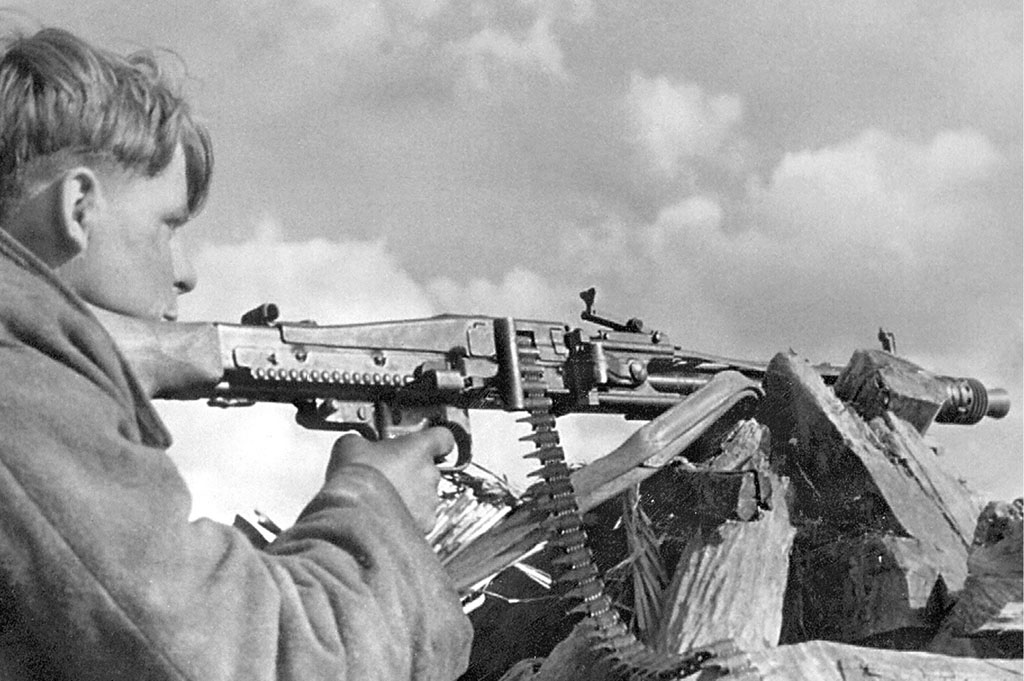
MG42 in action • Courtesy Blake Stevens, MG34-MG42 German Universal Machine Guns, Collector Grade Publications


MG42 • Private NFA collection, Gary Gelson photo


HK23 • Courtesy Heckler & Koch
Postwar models, the MG42/59 followed by the MG1 then the MG3, are still in use by the German army. These postwar guns are chambered for the 7.62×51mm cartridge. These models utilize many important improvements in manufacturing and design, and are in use by many countries throughout the world. There are a number of licensed versions of the MG42/59 made in Austria, Italy, Spain, Portugal, Turkey, Yugoslavia, and Switzerland.
MG42
Pre-1968
Exc. |
V.G. |
Fair |
40000 |
35000 |
32500 |
Pre-1986 manufacture with new receiver or re-weld
Exc. |
V.G. |
Fair |
32500 |
30000 |
25000 |
NOTE: For MG42/5 and MG42/59 add 75 percent premium (eight examples known). For MG3 add 125 percent (three known).
HK11 (HK11A1-HK11E)
Designed as a light air-cooled machine gun chambered for the 7.62×51mm cartridge, this gun uses a roller-delayed bolt. The quick change barrel is 17.7 inches long. Fixed synthetic stock with pistol grip and bipod. Uses a 20-round box magazine or 80 dual drum. Rate of fire is about 850 rounds per minute. Weight is approximately 15 lbs.
NOTE: There is no drum magazine on the HK11A1.
Pre-1968
Exc. |
V.G. |
Fair |
N/A |
N/A |
N/A |
Pre-1986 manufacture with new receiver or re-weld
Exc. |
V.G. |
Fair |
16500 |
14000 |
12000 |
HK13 (HK13E)
This gun is similar to the HK11 but is chambered for the 5.56×45mm cartridge. Quick change 17.7-inch barrel. Fed by a 20-, 30-, or 40-round box magazine, or 100-round dual drum. Rate of fire is about 800 rounds per minute. Weight is approximately 12 lbs.
NOTE: There are a number of variants of this model. The HK13C has a baked-on forest camouflage finish. The HK13E is a modernized version with selective improvements, such as a 3-round burst capability. The rifling has been changed to stabilize 62 grain bullets. The HK13E1 is the same as the HK13E with rifling twist to accommodate 54 grain bullets. The HK13S has a baked-on desert camouflage scheme.
NOTE: There is a semi-automatic version of this gun. Value would be around $6,000 for one in excellent condition.
Pre-1968
Exc. |
V.G. |
Fair |
N/A |
N/A |
N/A |
Pre-1986 manufacture with new receiver or re-weld
Exc. |
V.G. |
Fair |
15000 |
13000 |
11000 |
HK21 (HK21E-HK23E)
These guns form a series of general purpose machine guns. The 21 series is chambered for the 7.62×51mm cartridge while the 23E is chambered for the 5.56×45mm cartridge. The HK21 is fitted with a 17.5-inch barrel and has a rate of fire of 900 rounds per minute. Its weight is about 17 lbs. Marked on the top of receiver. The HK21 was first produced in 1970 but is no longer in production, while the HK21E and 23E are still produced.
This series of guns has variations similar to the HK13 series of guns.
NOTE: The HK21E and HK23E will bring a premium of 75 percent over the older HK21/2.
Pre-1968 Model 21

Exc. |
V.G. |
Fair |
20000 |
17500 |
16000 |
Pre-1986 manufacture with new receiver or re-weld
Exc. |
V.G. |
Fair |
20000 |
18000 |
17000 |